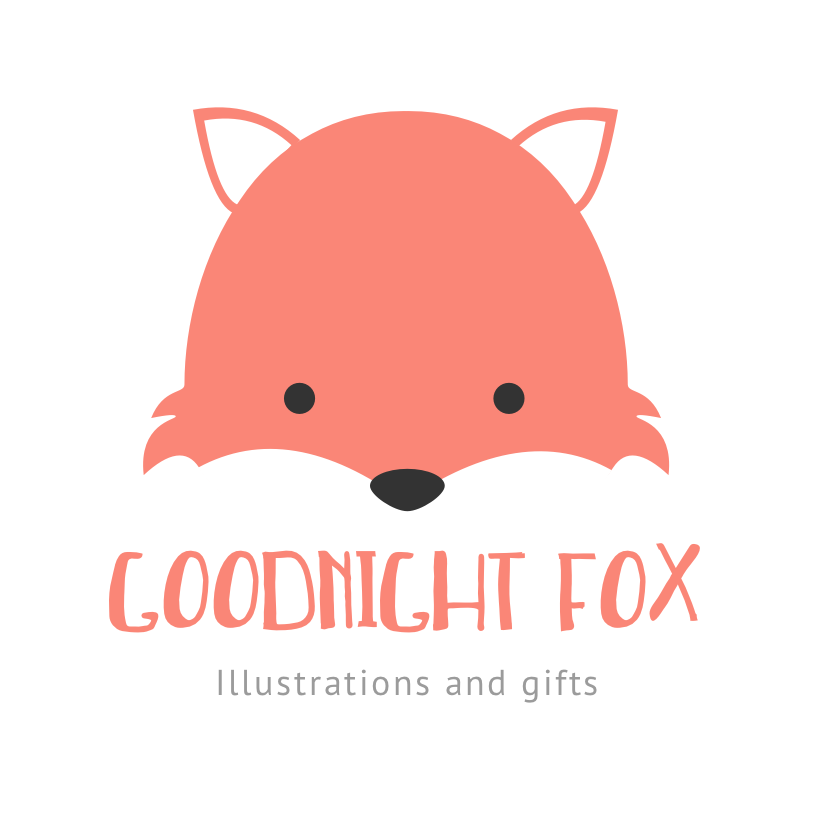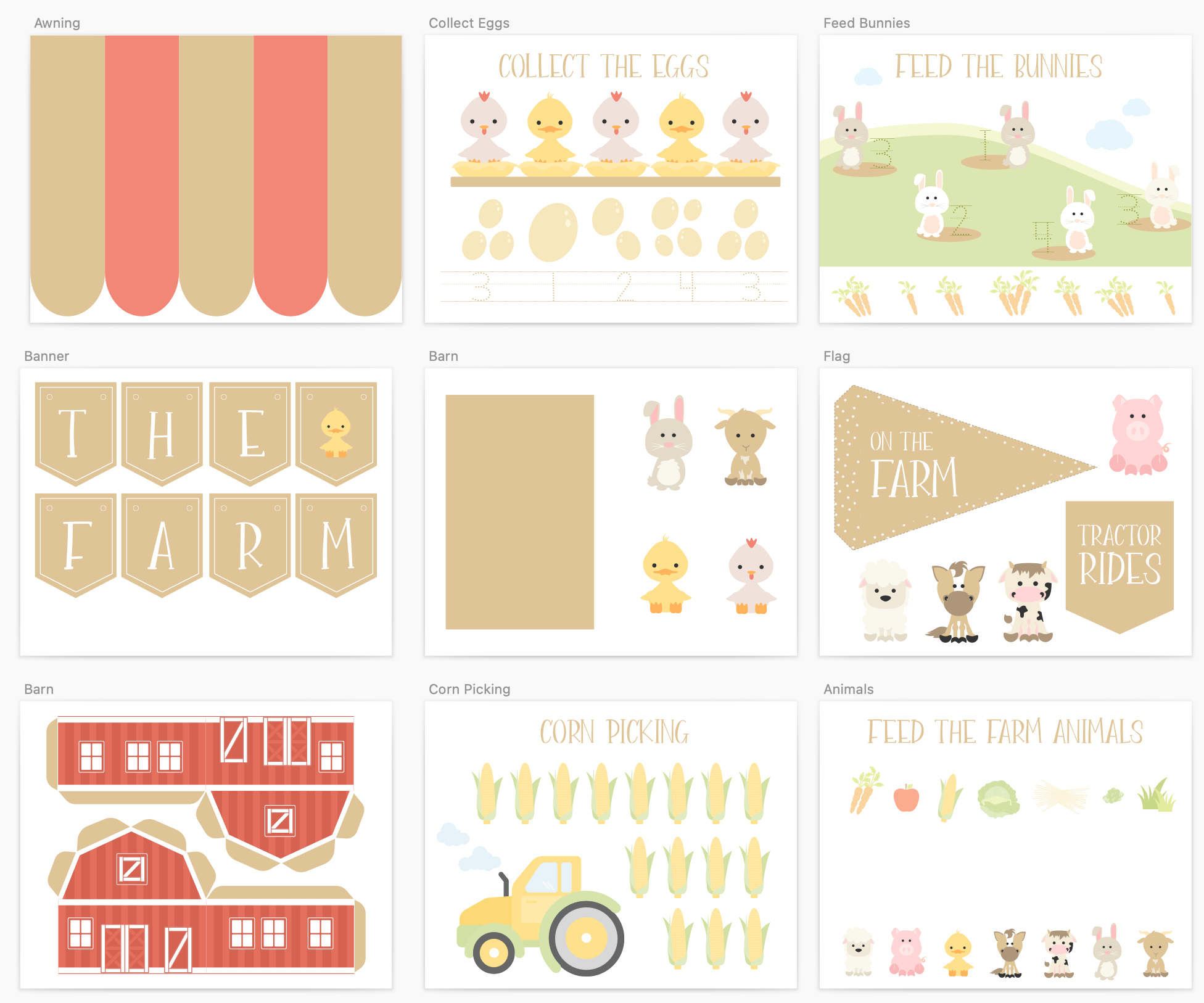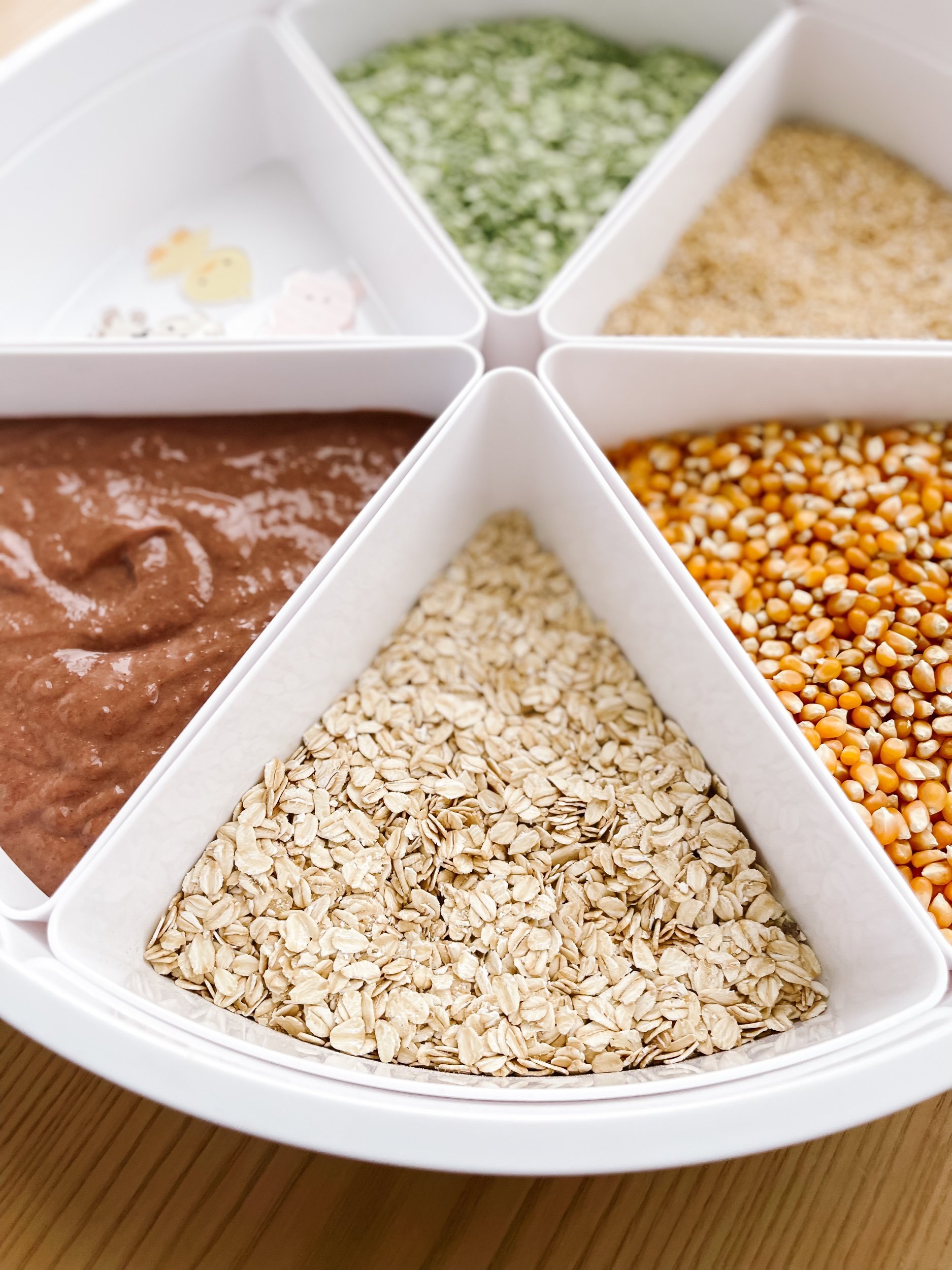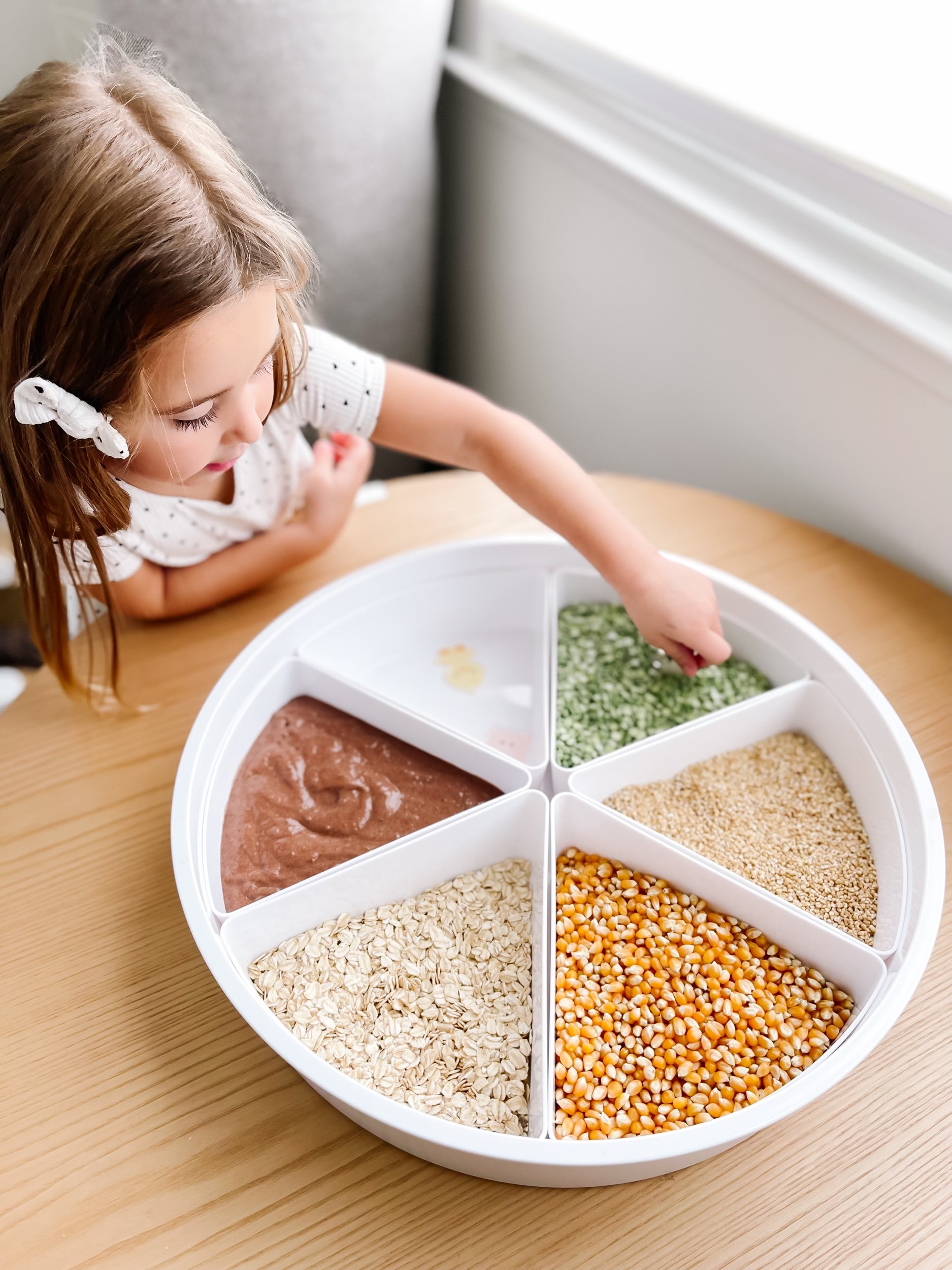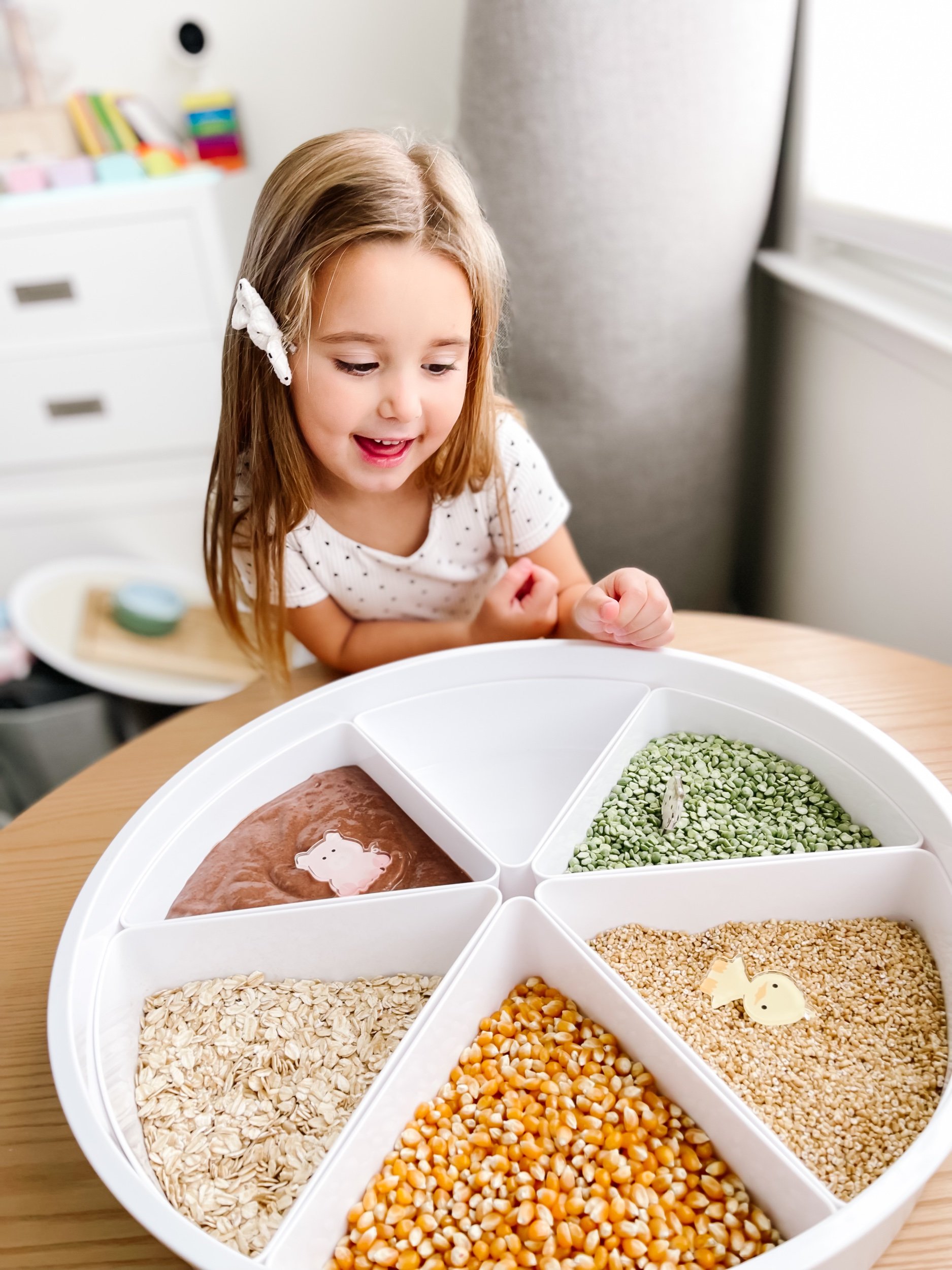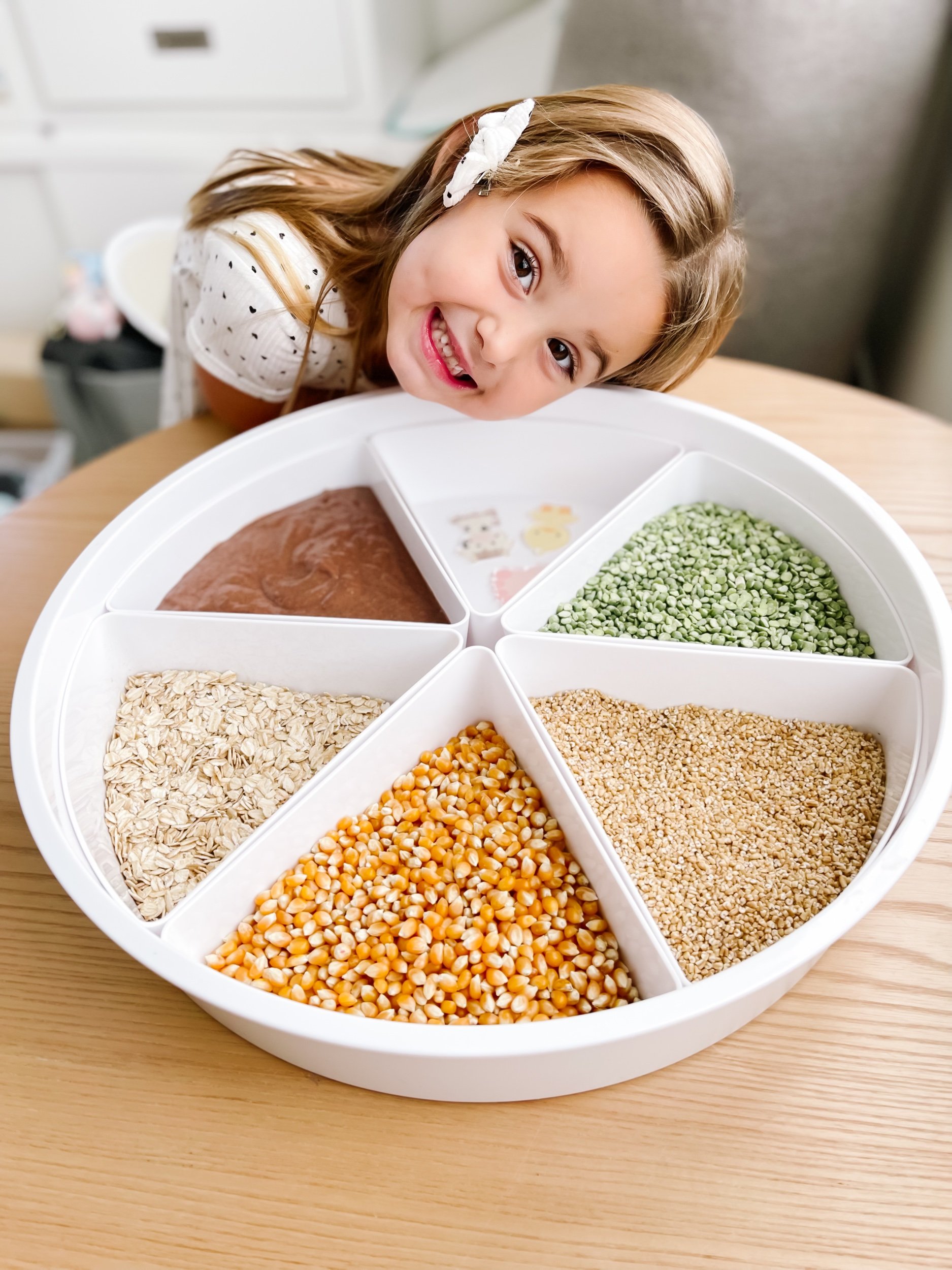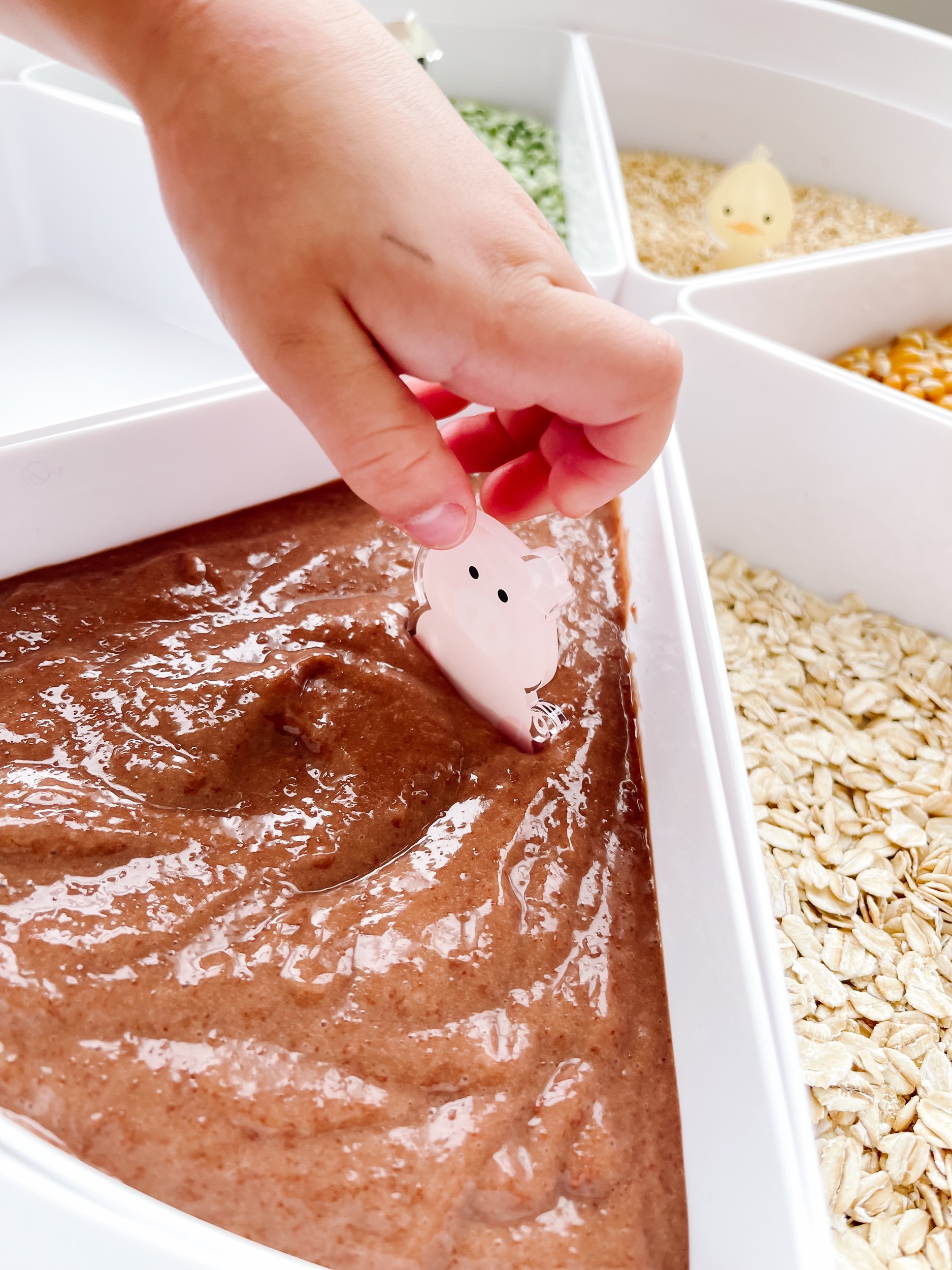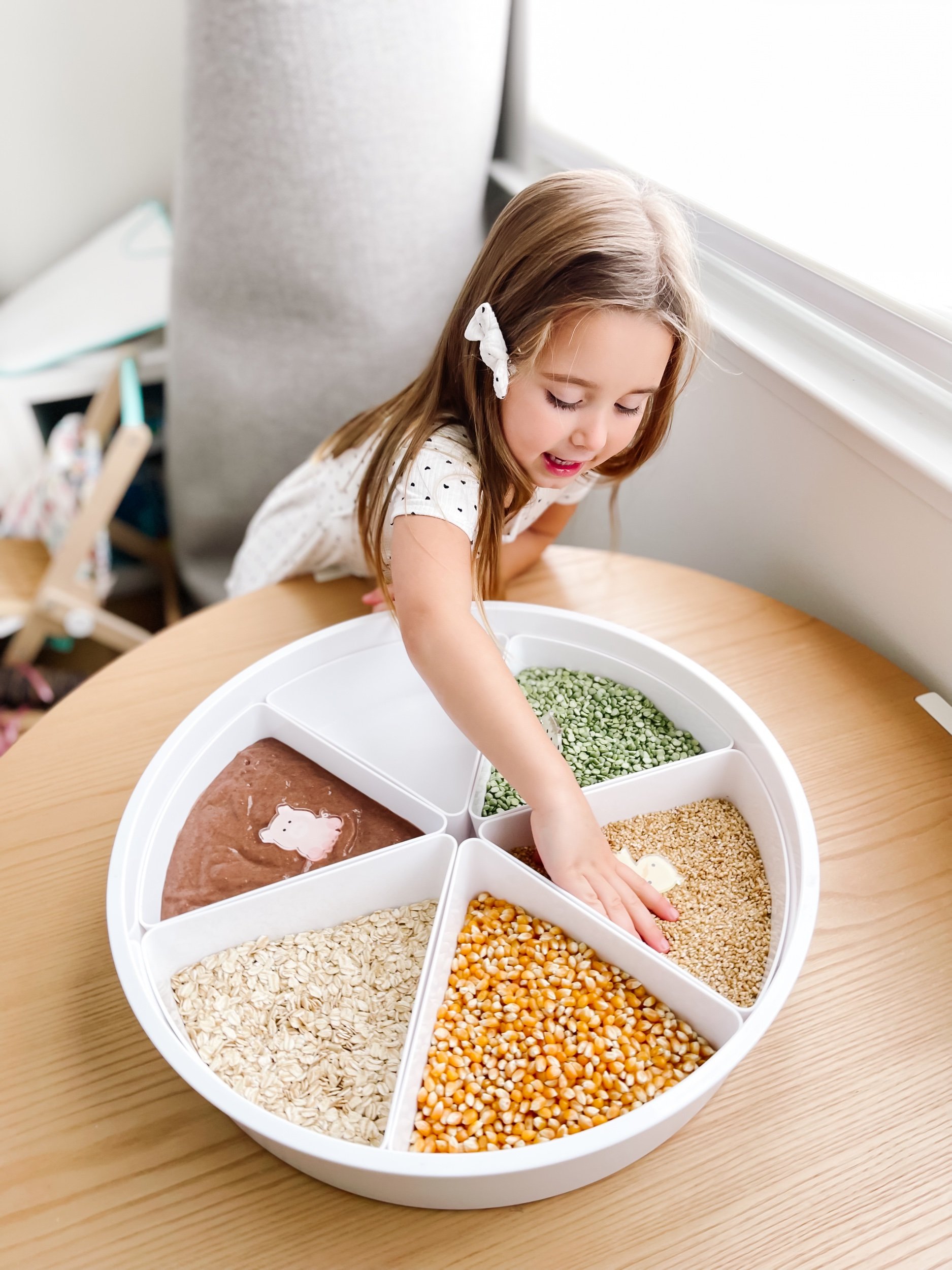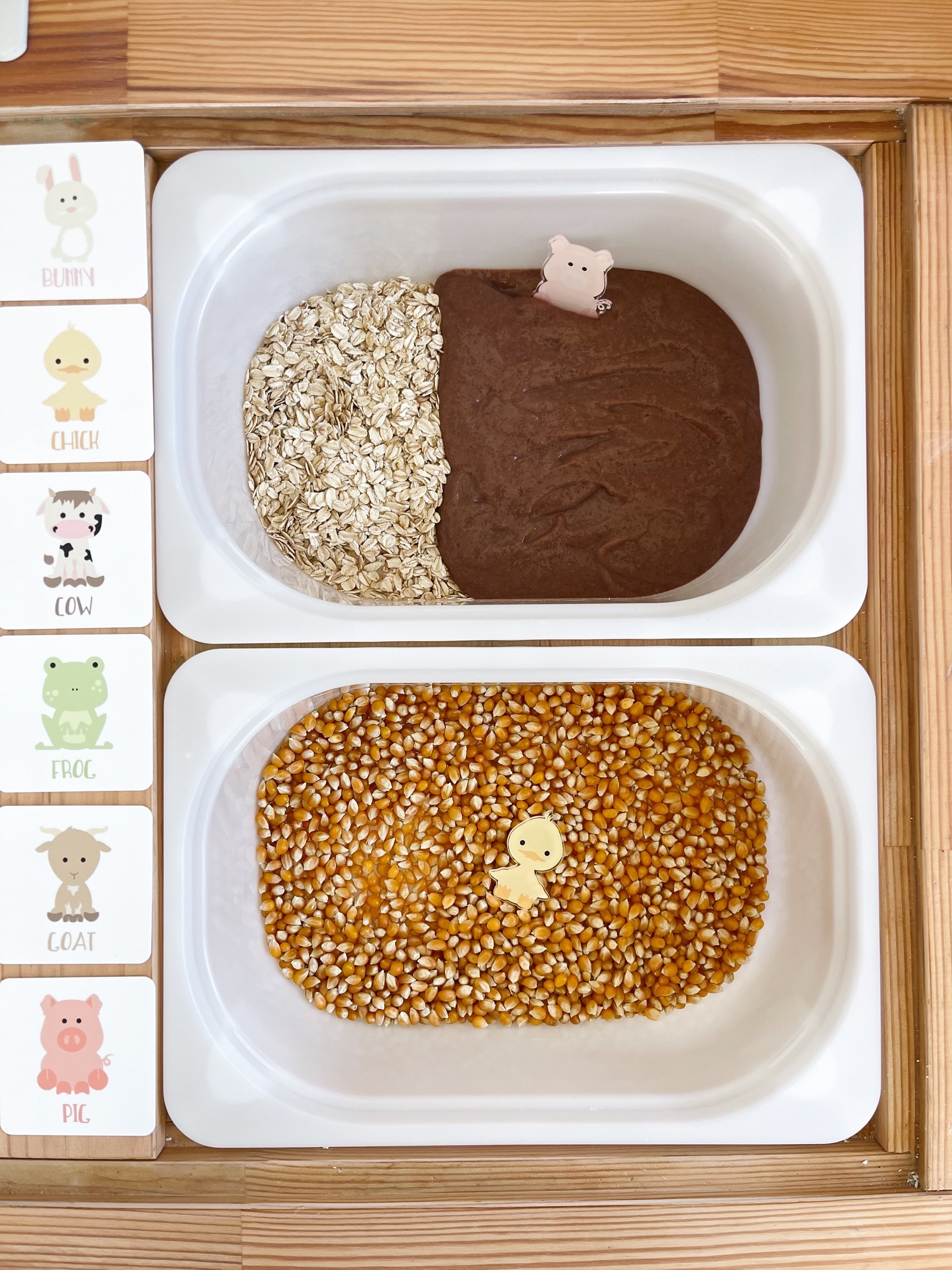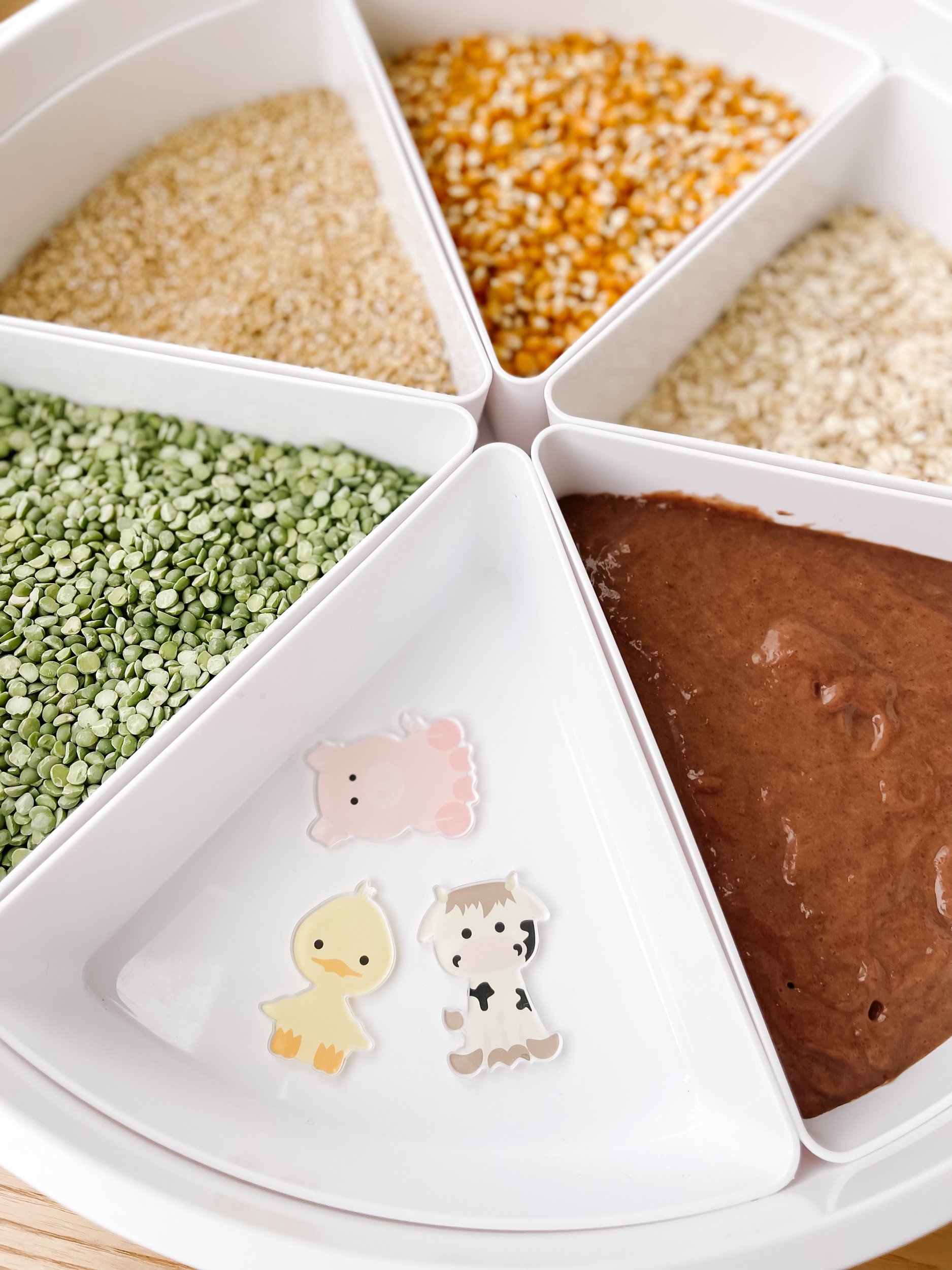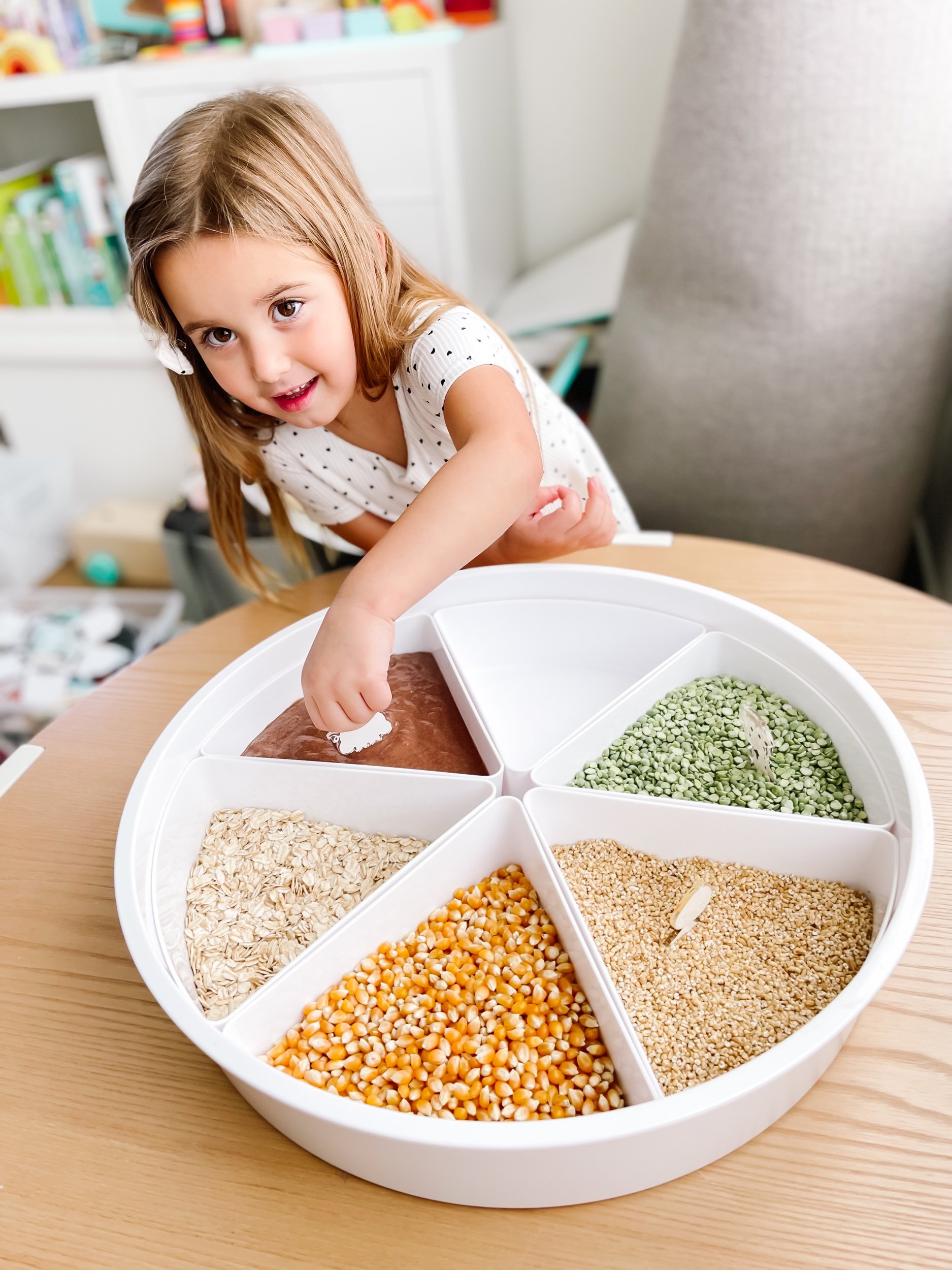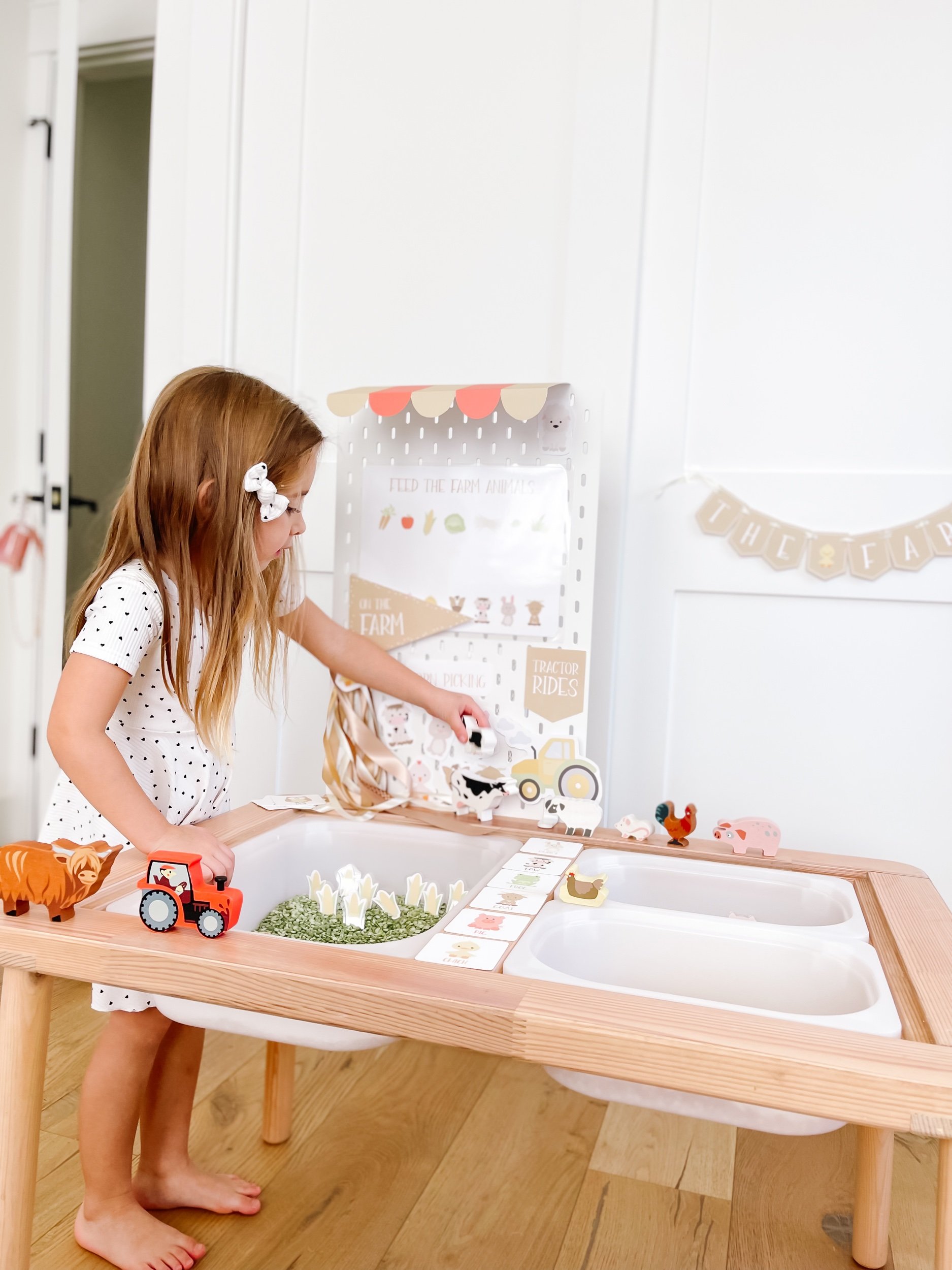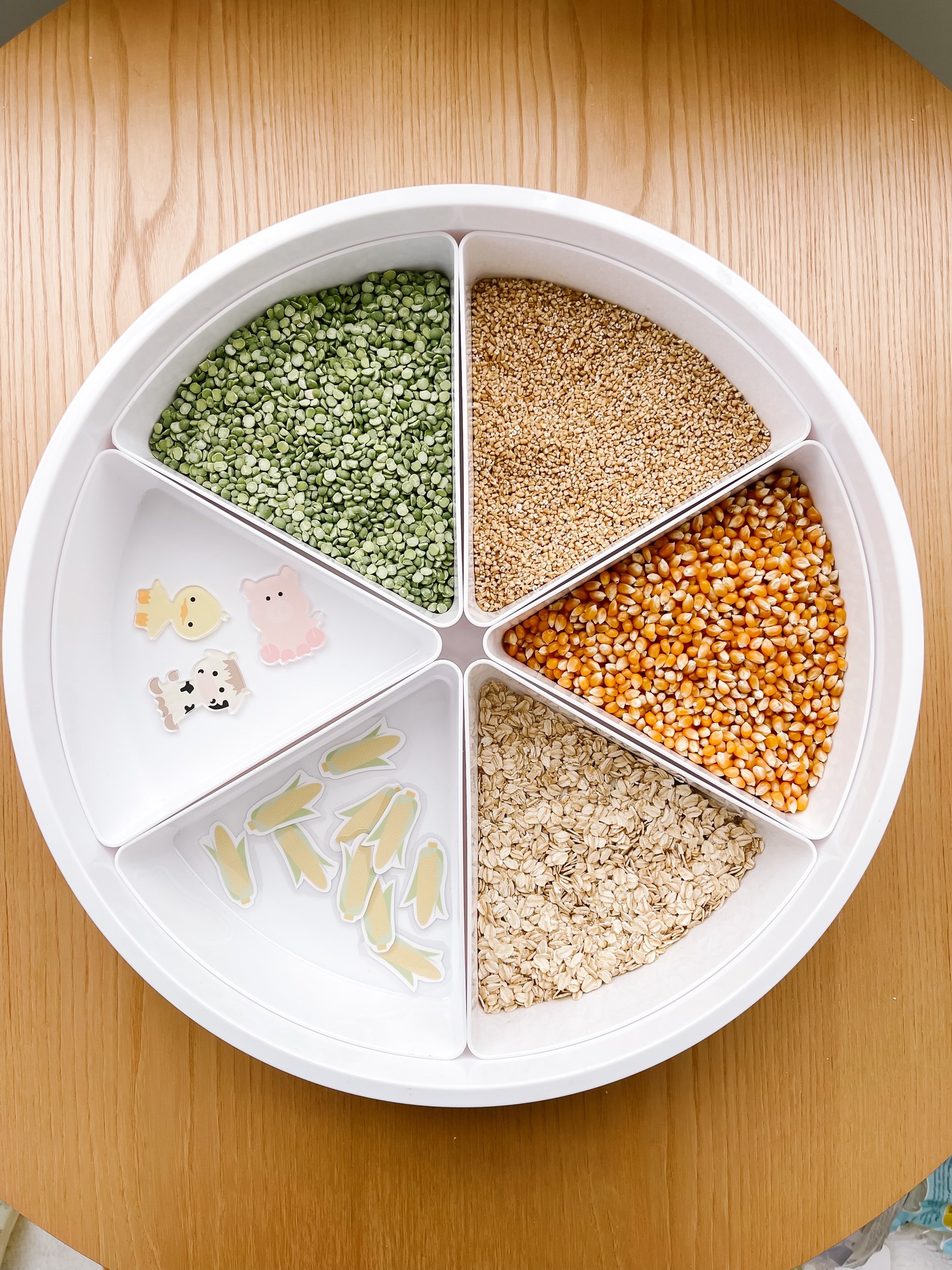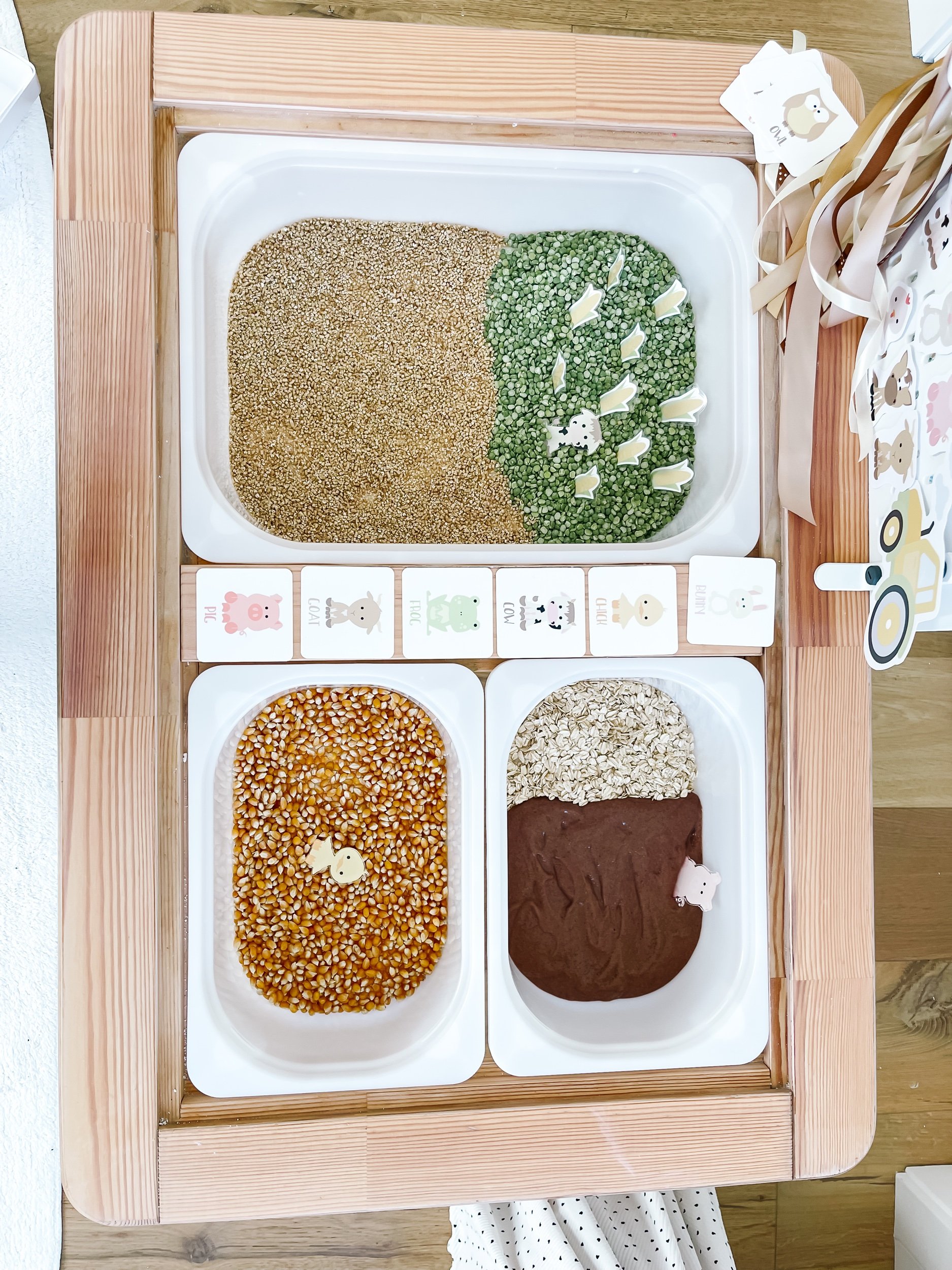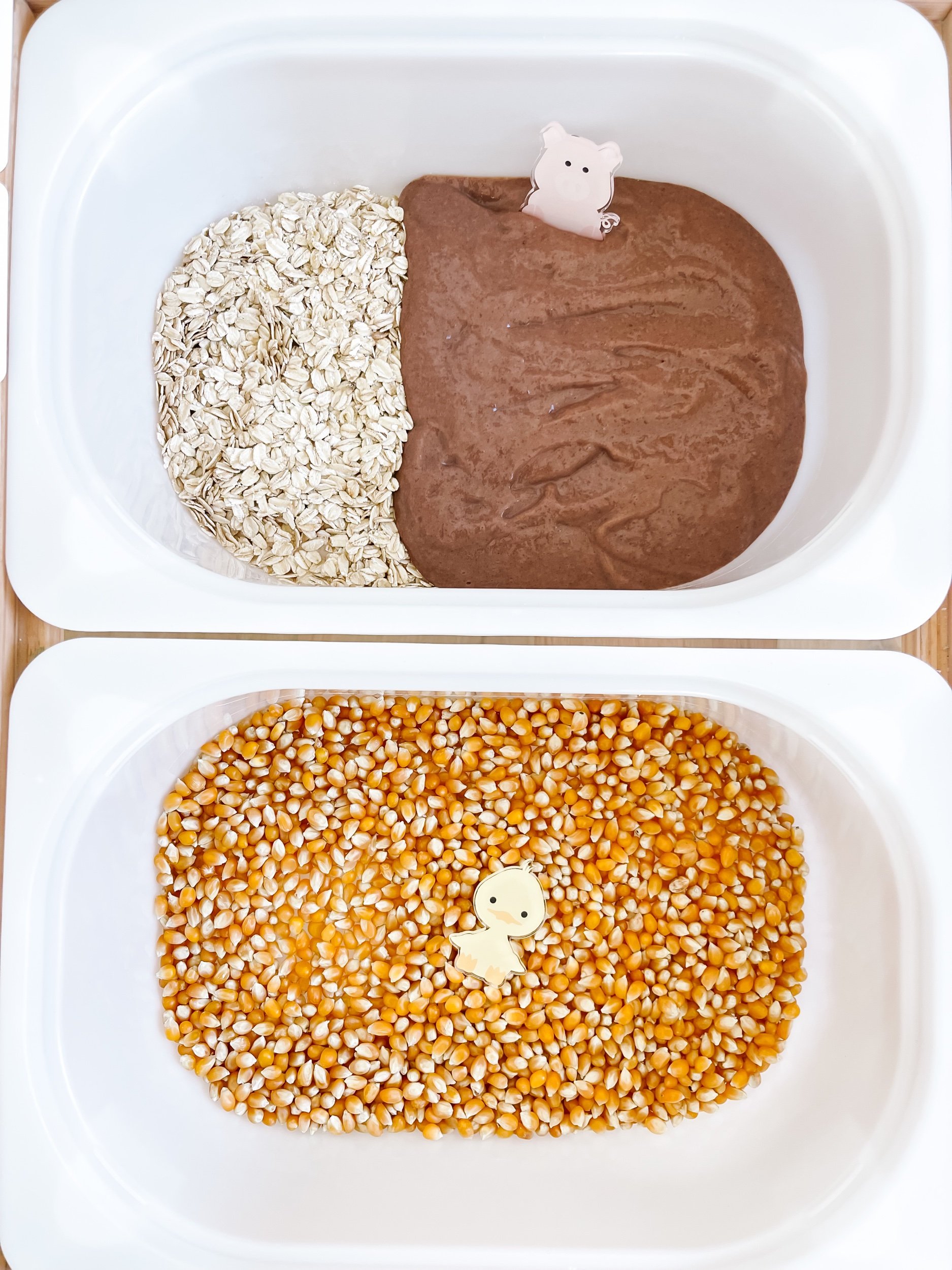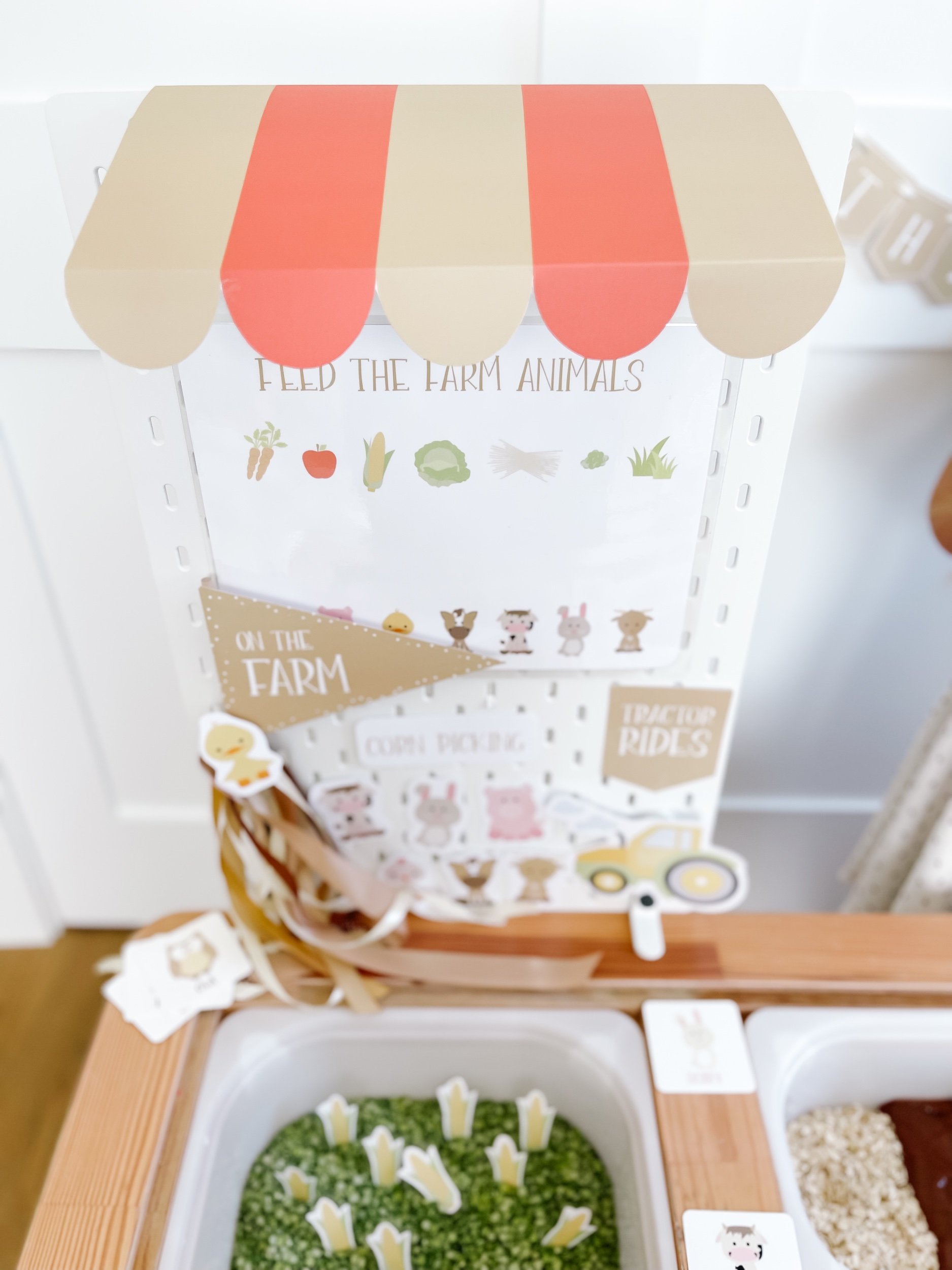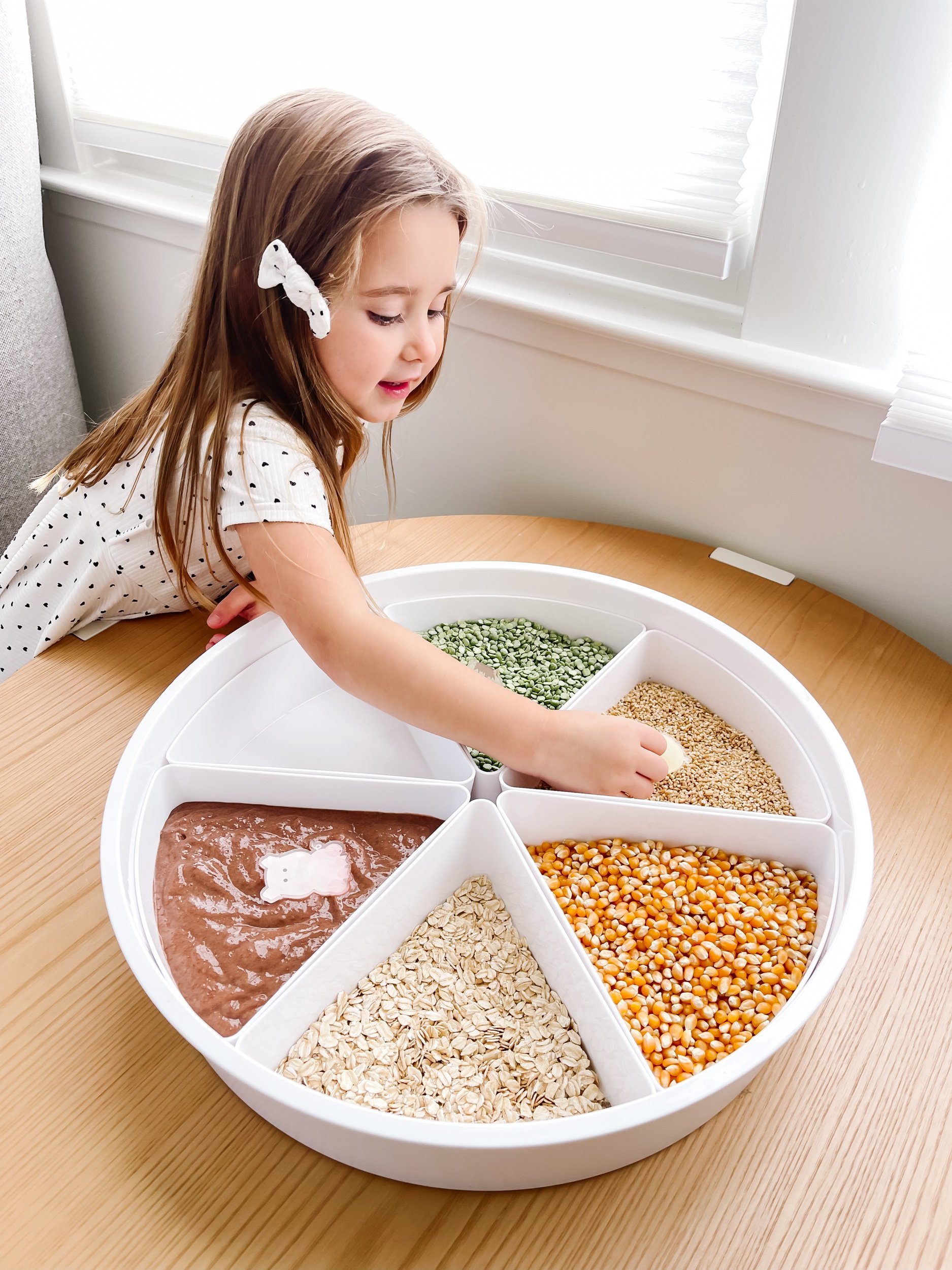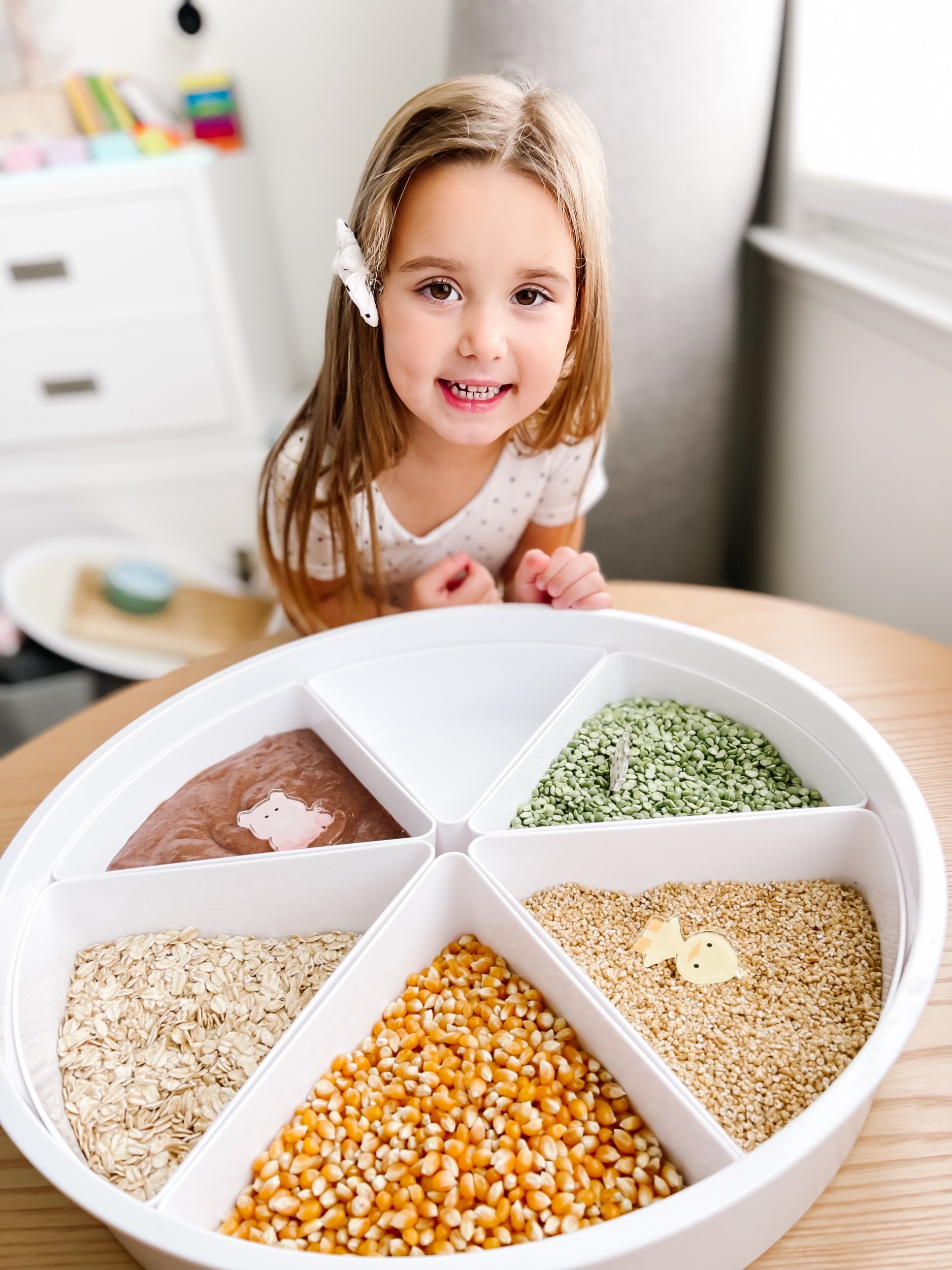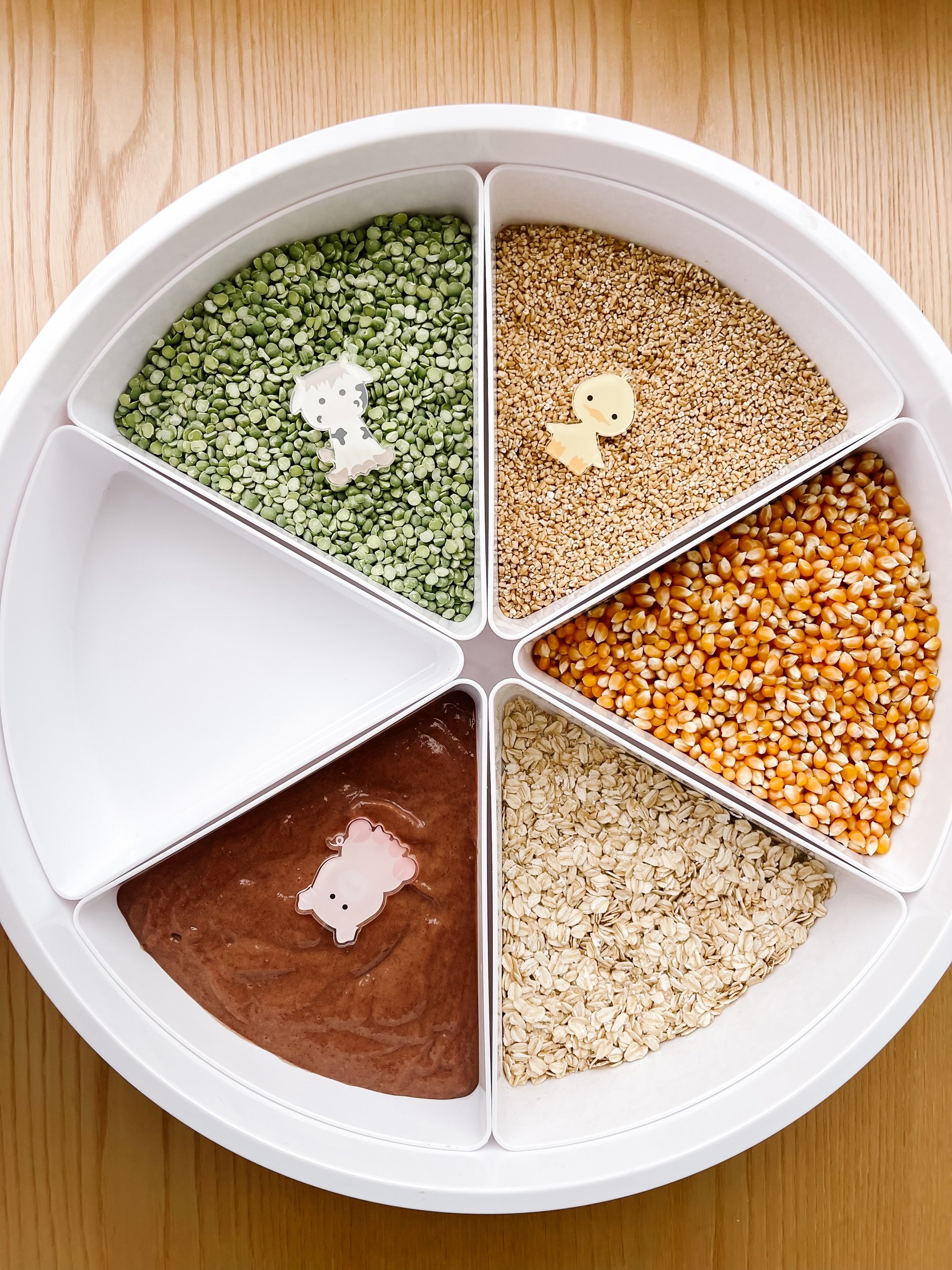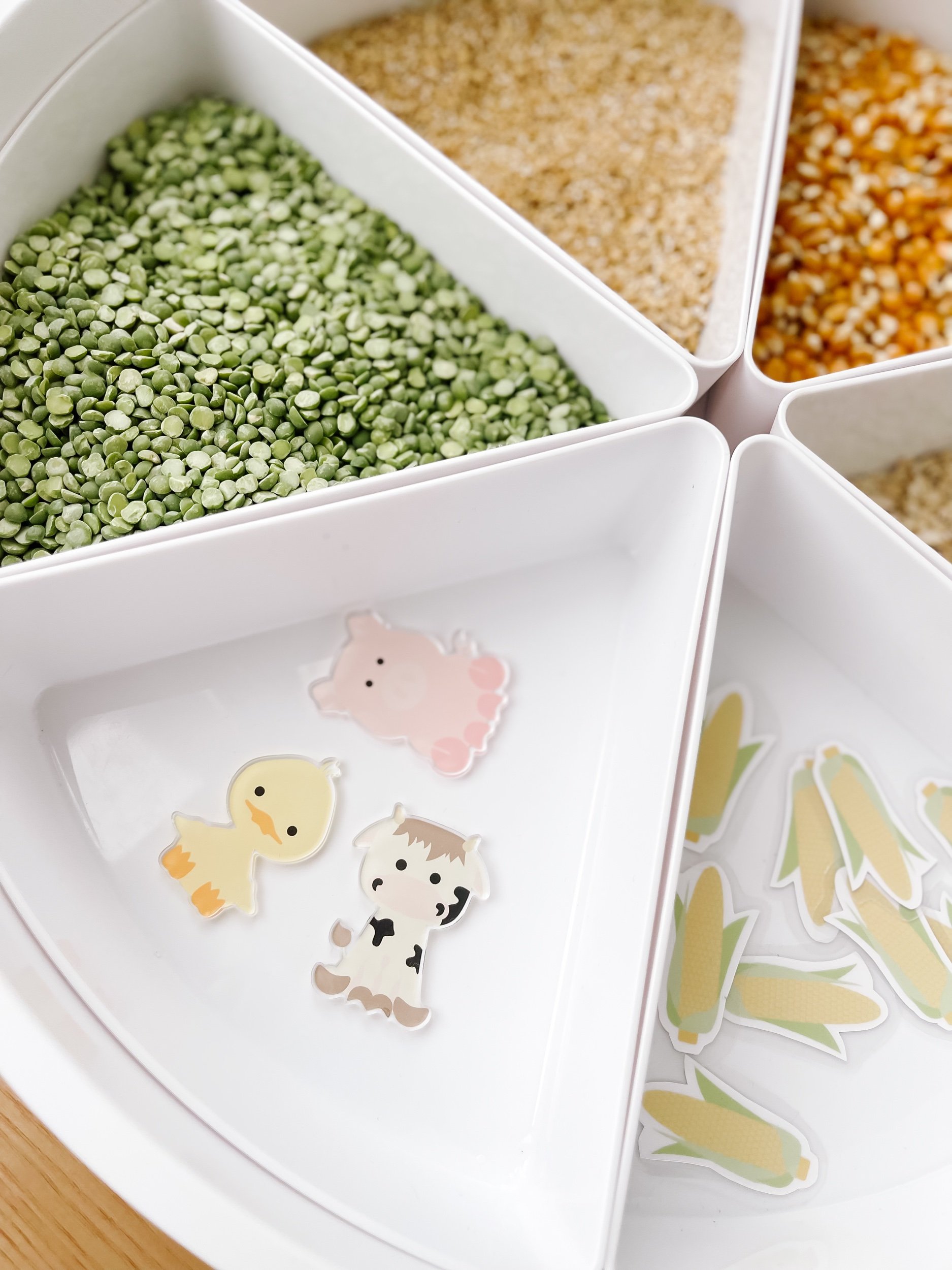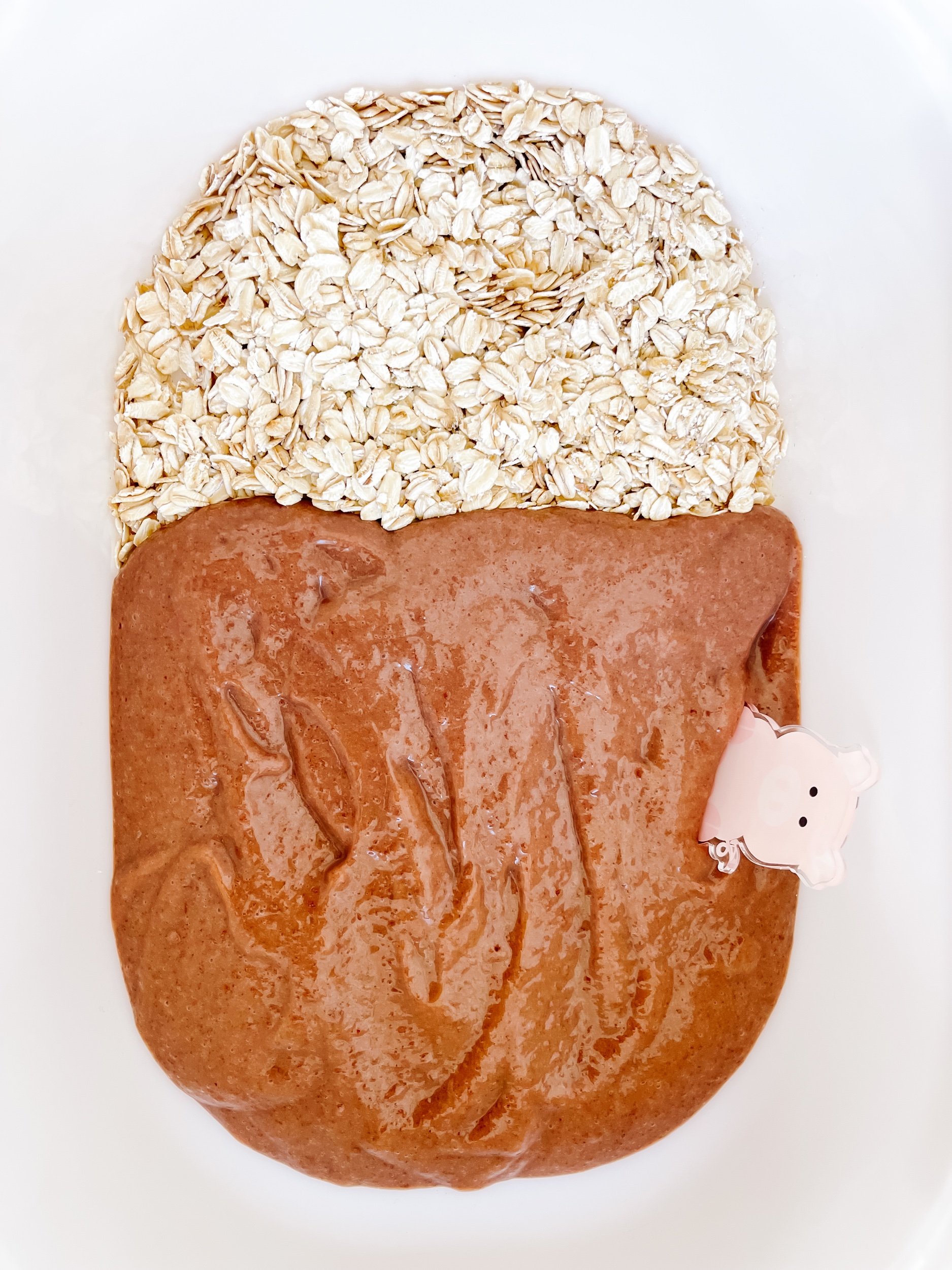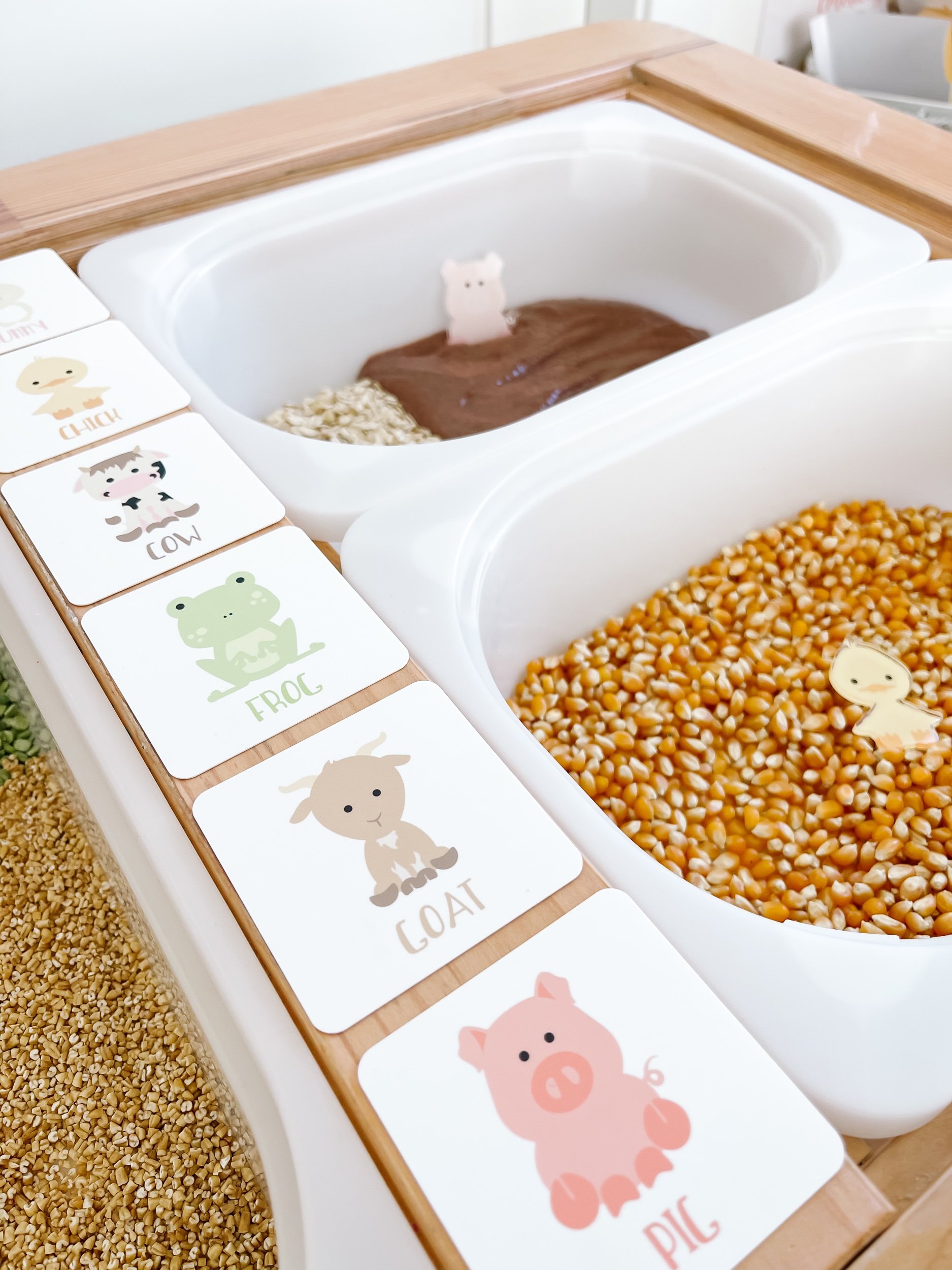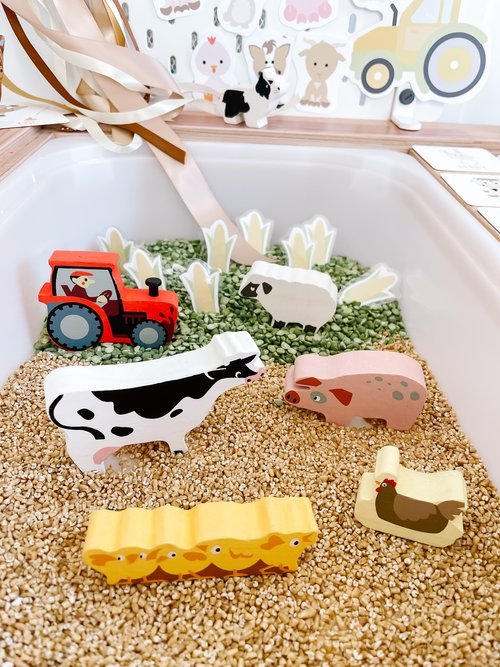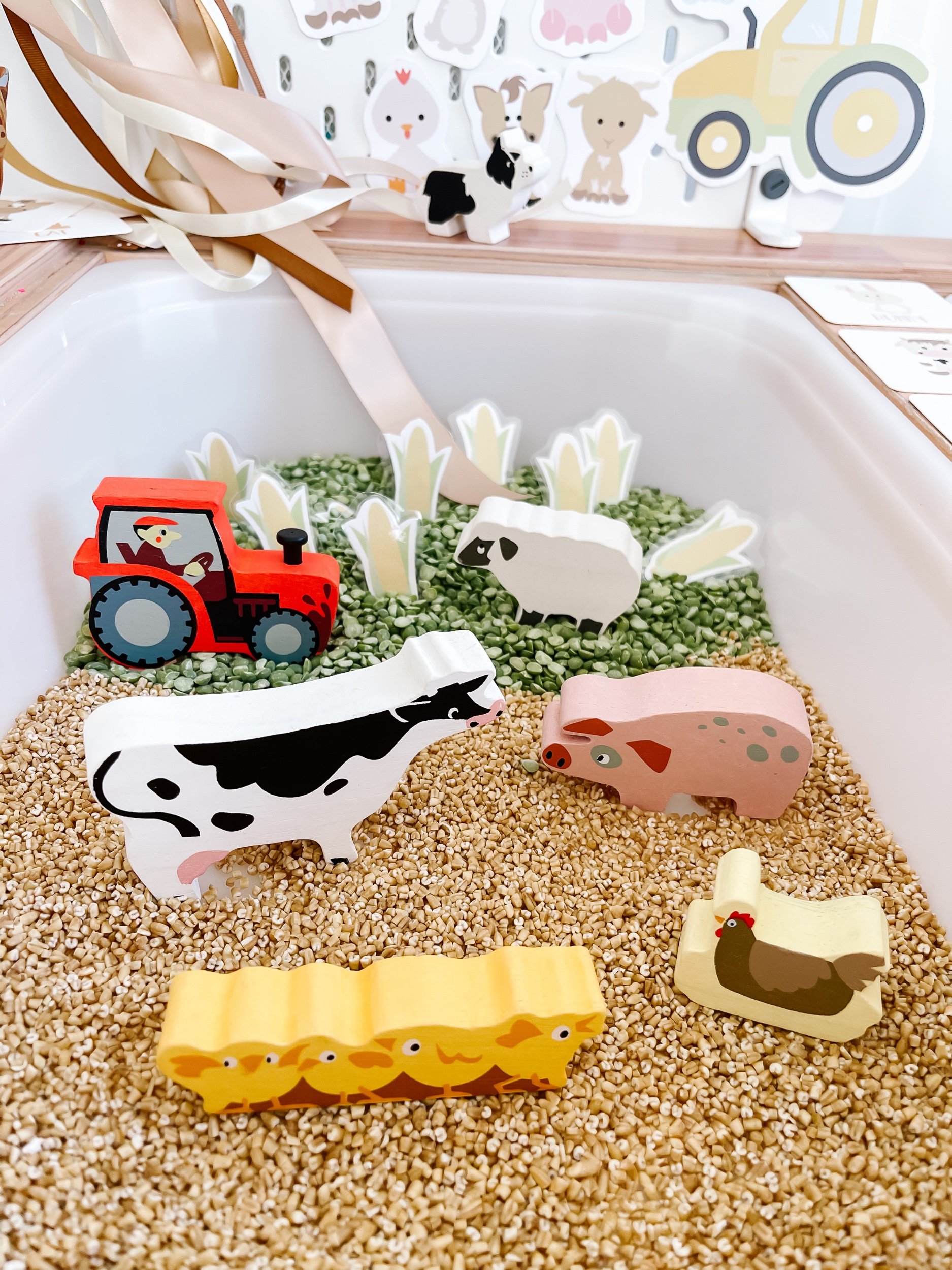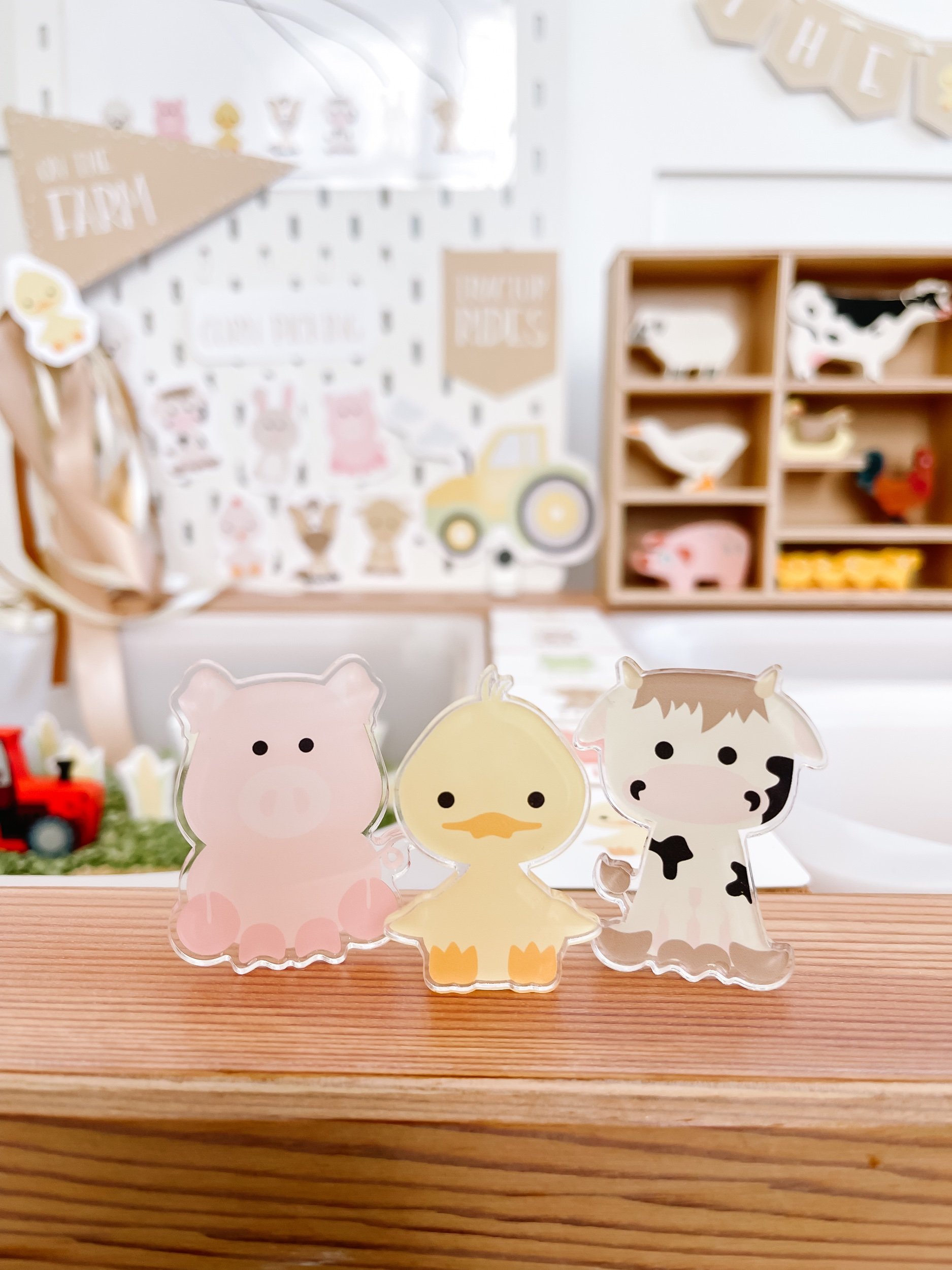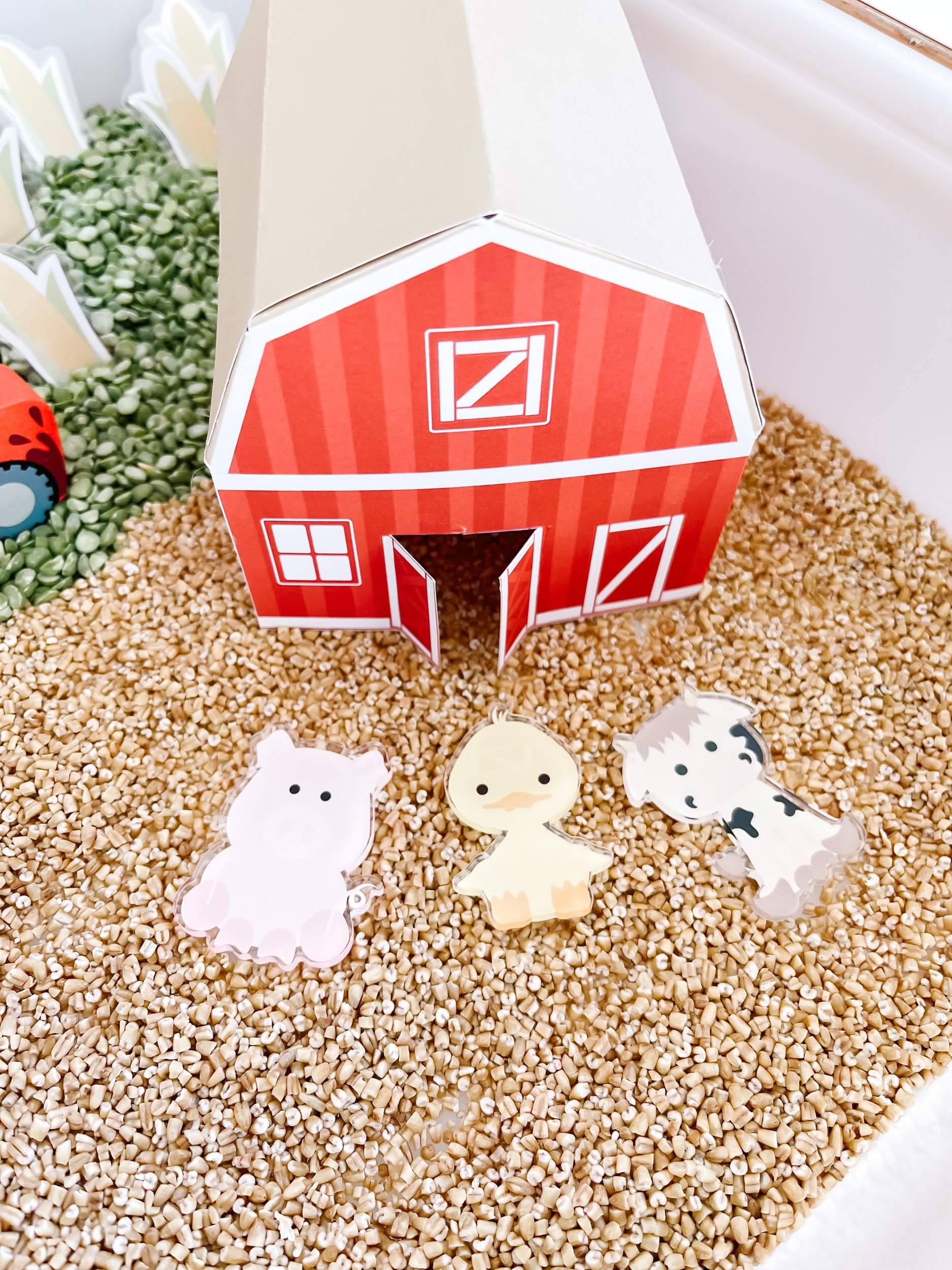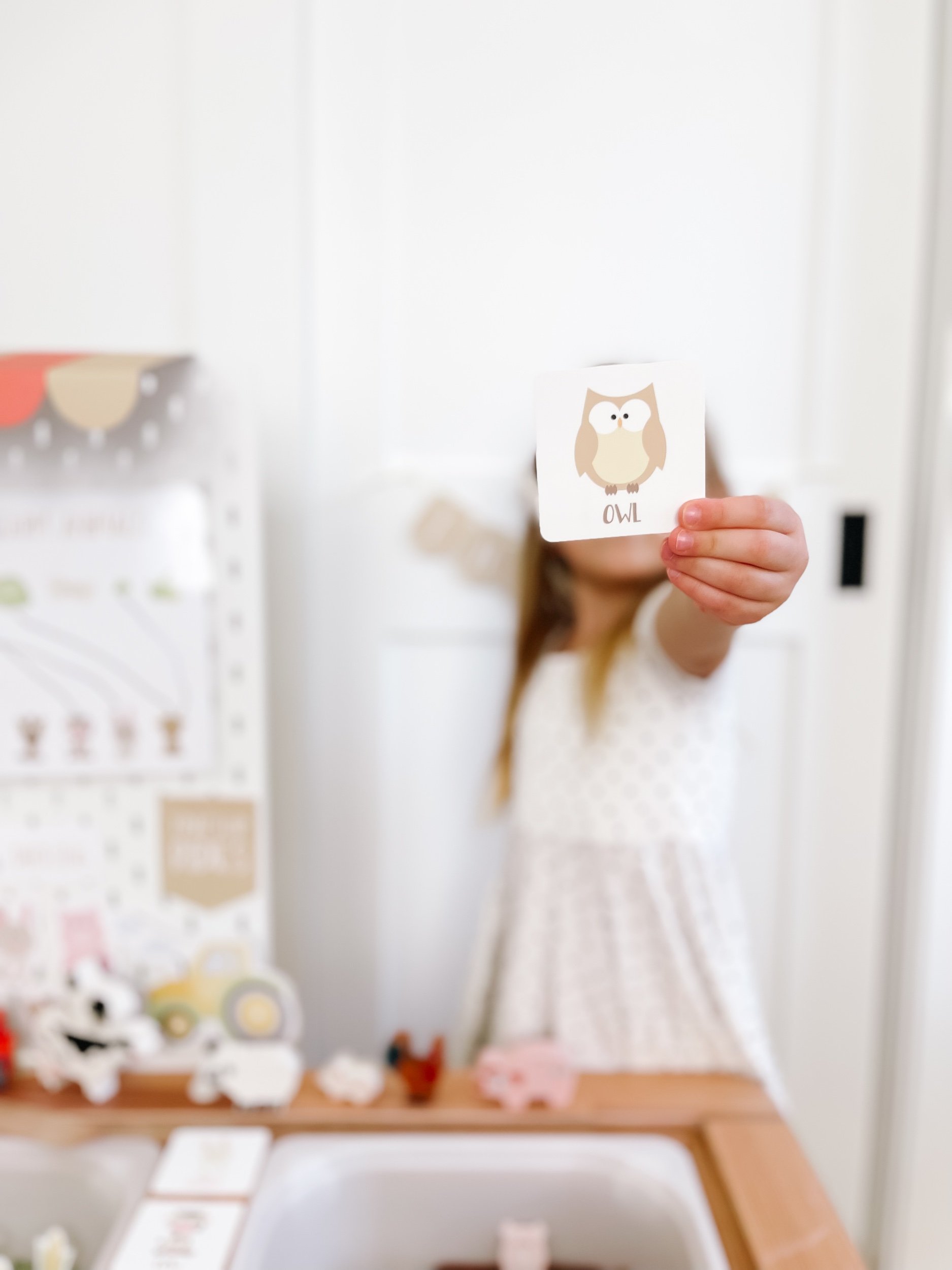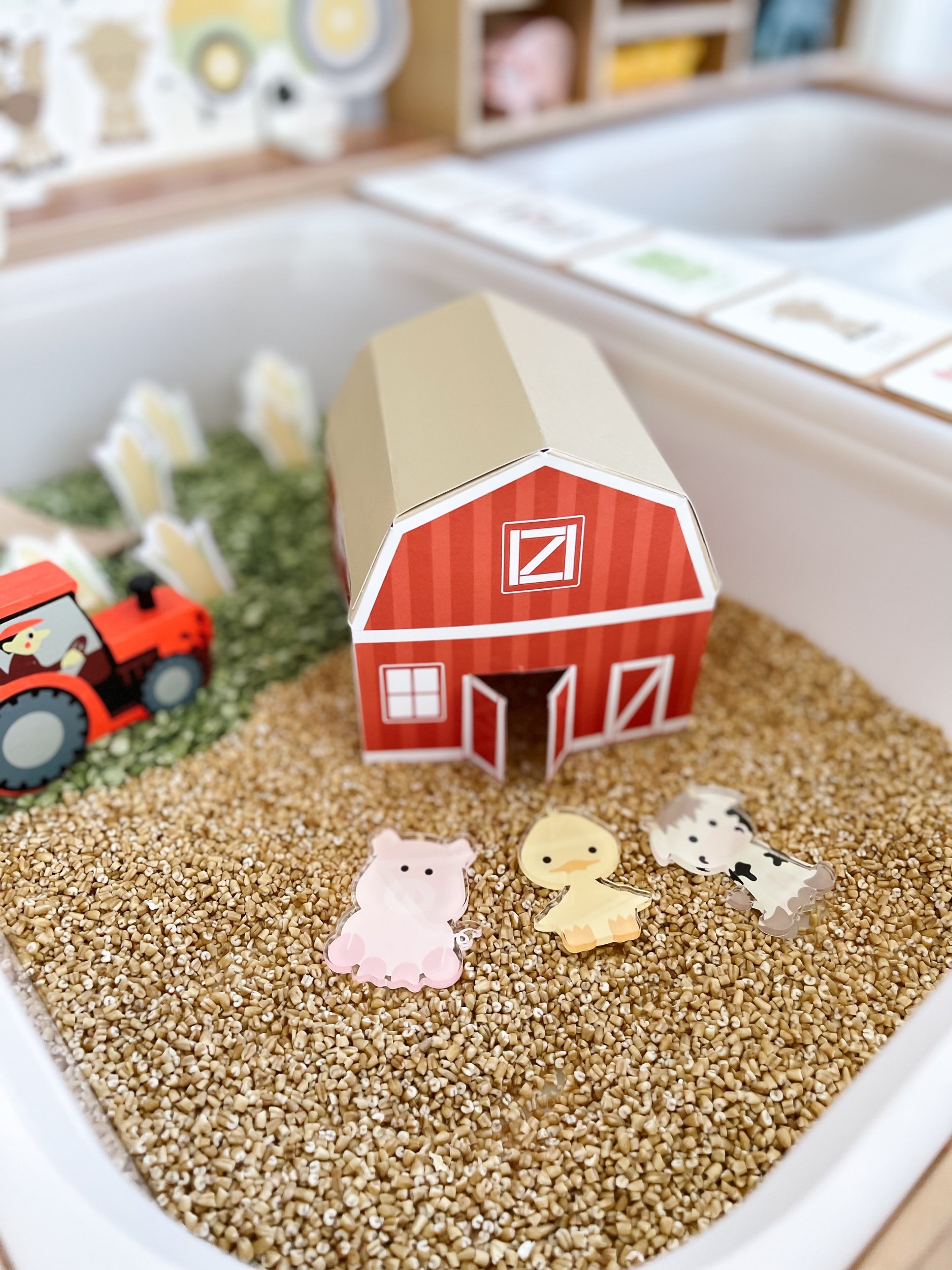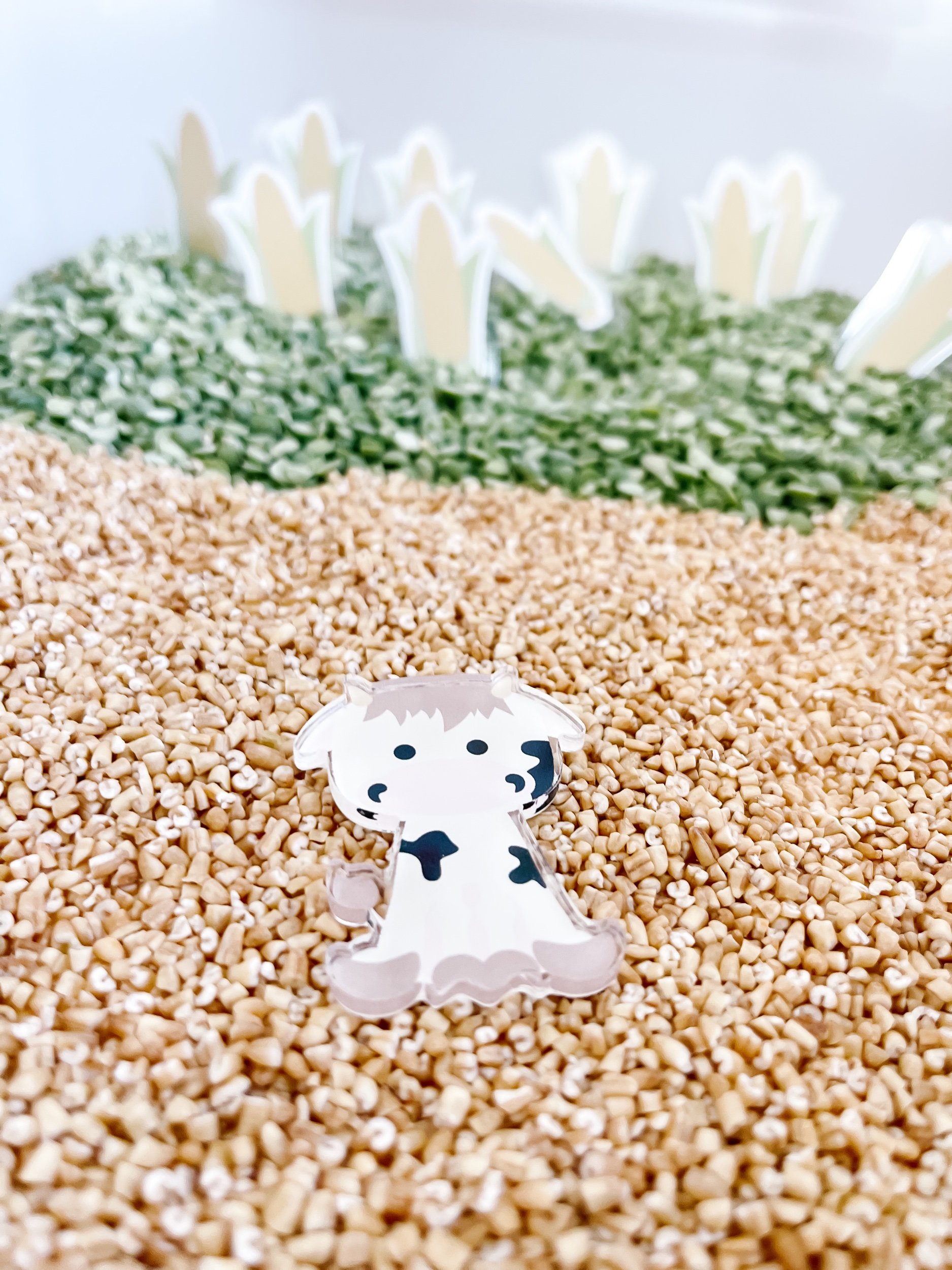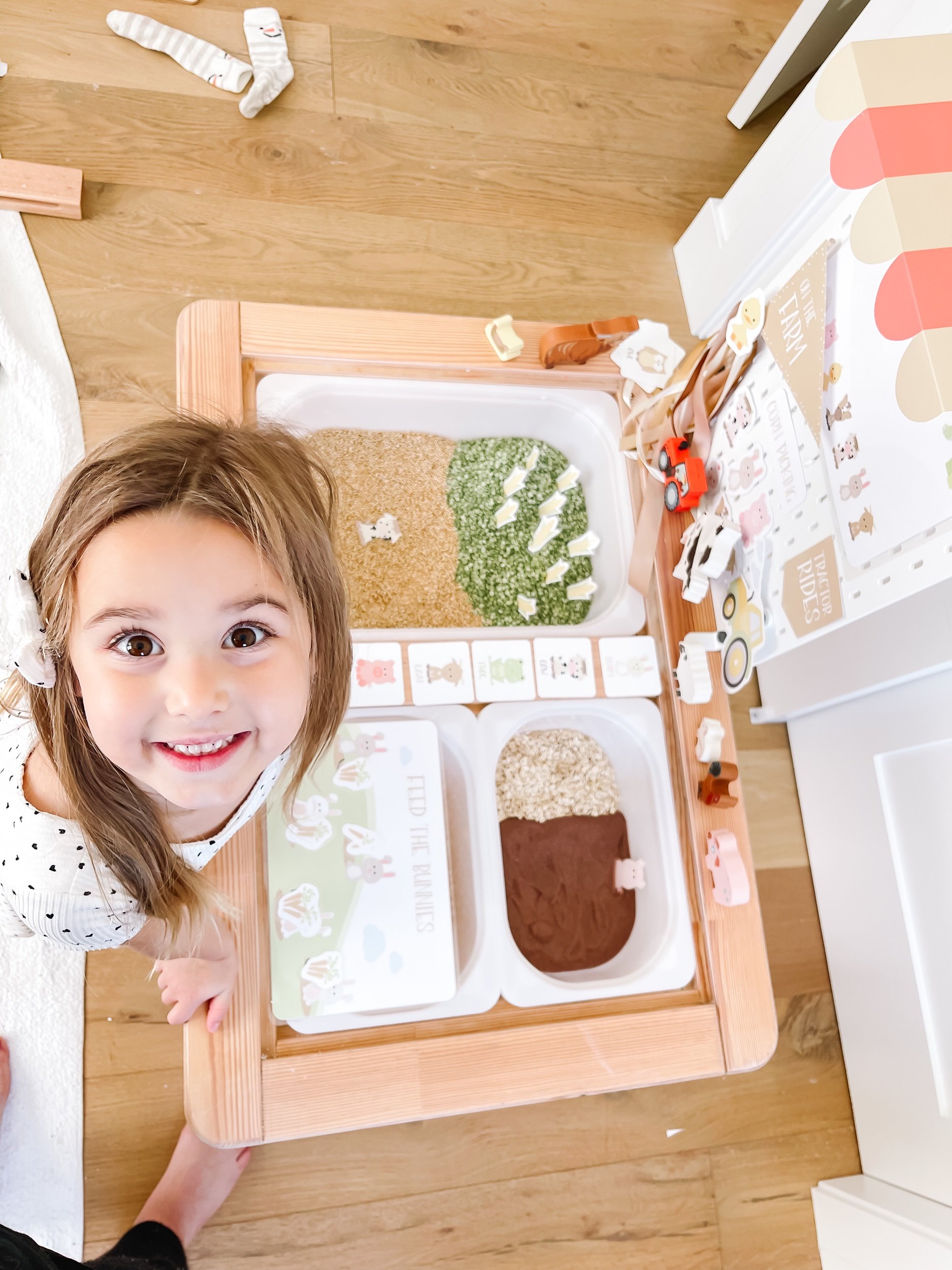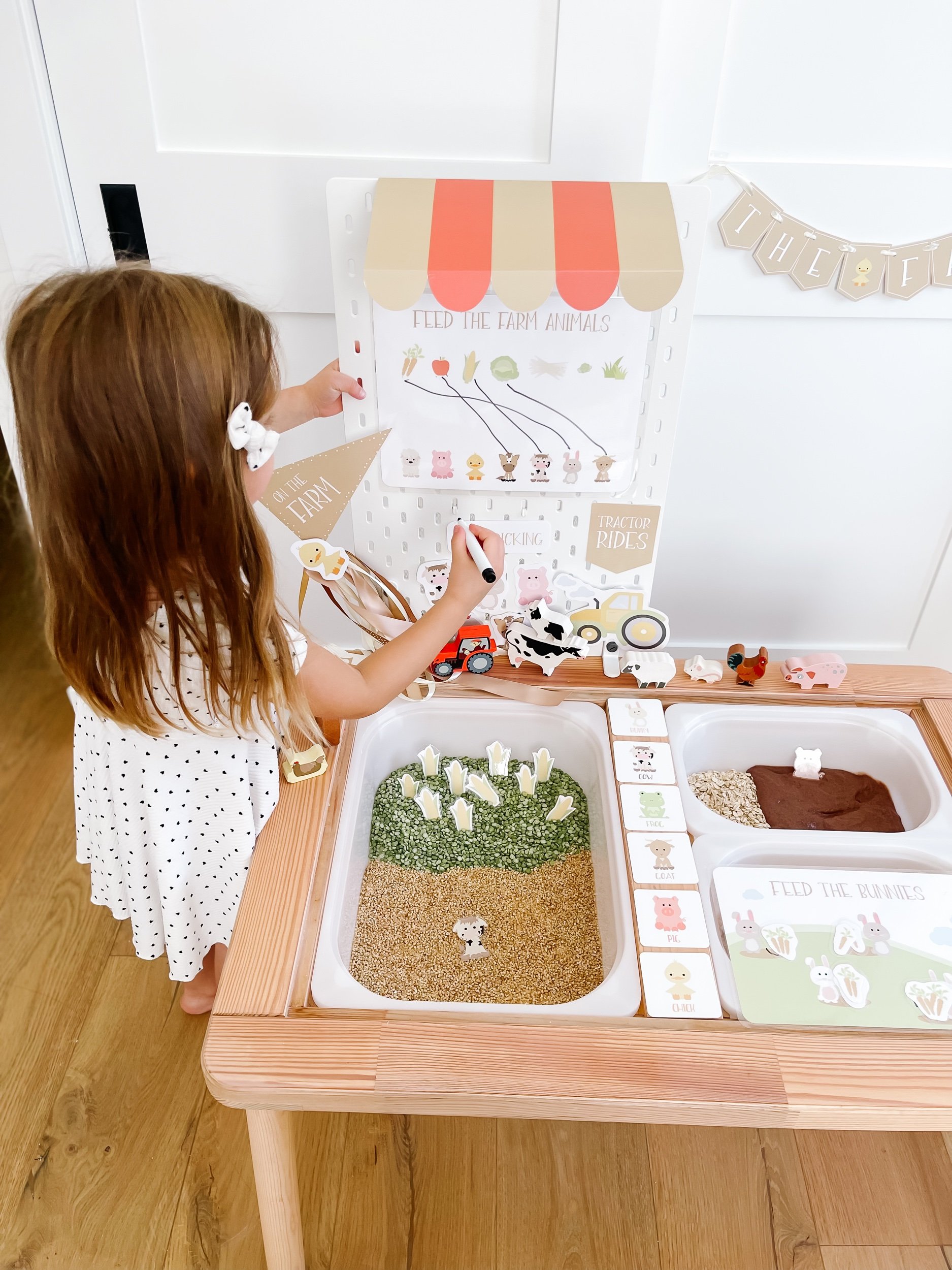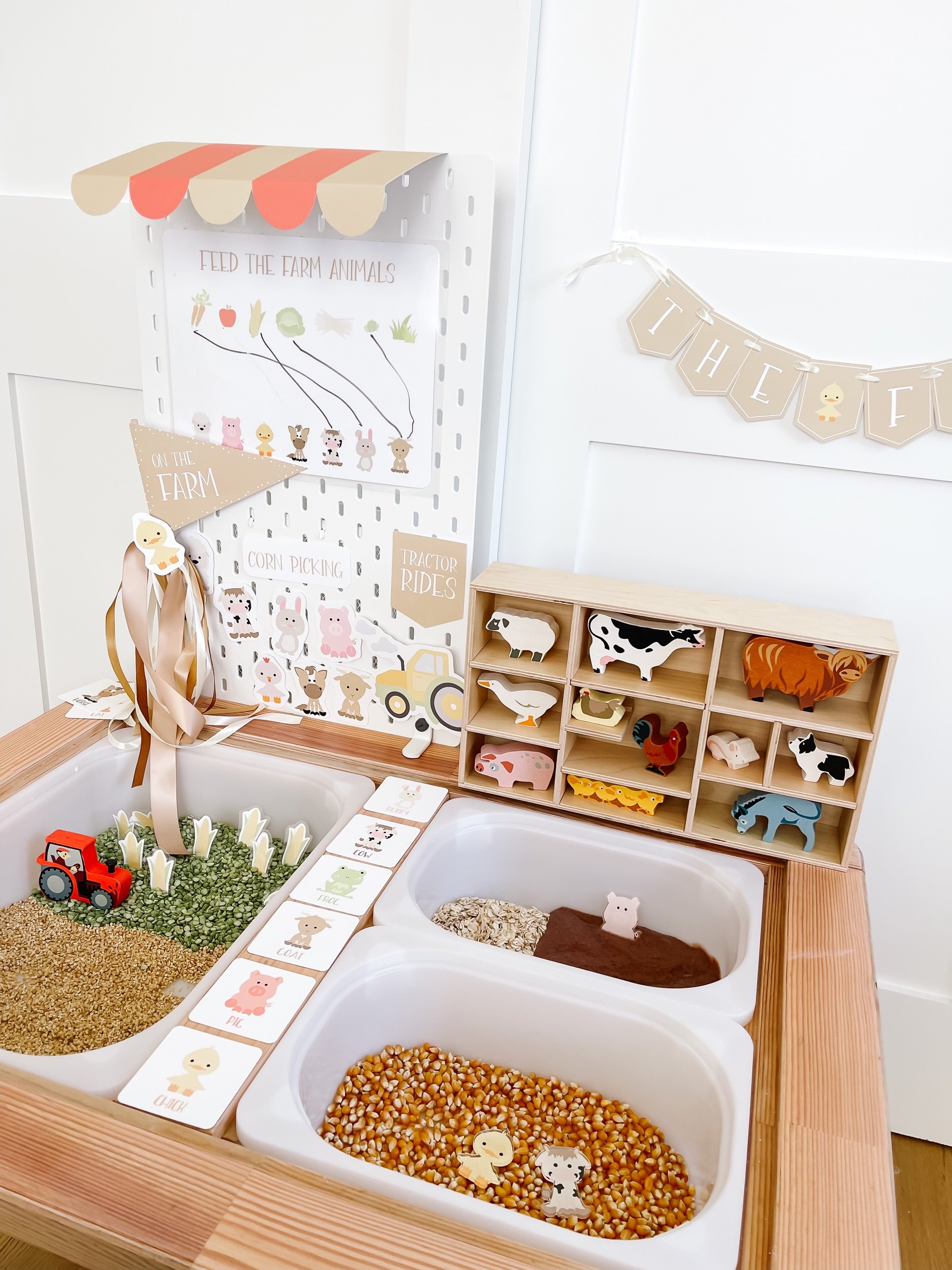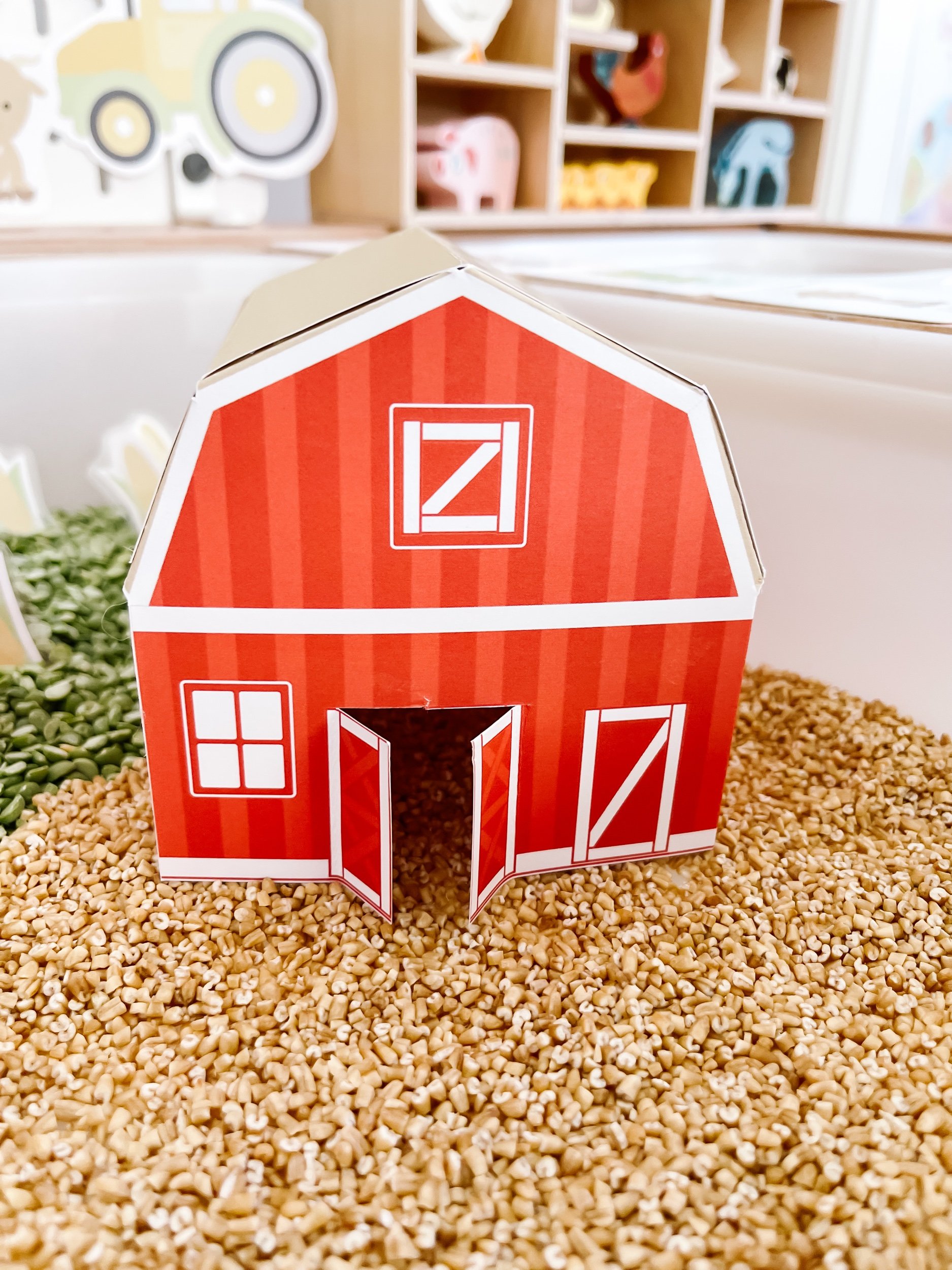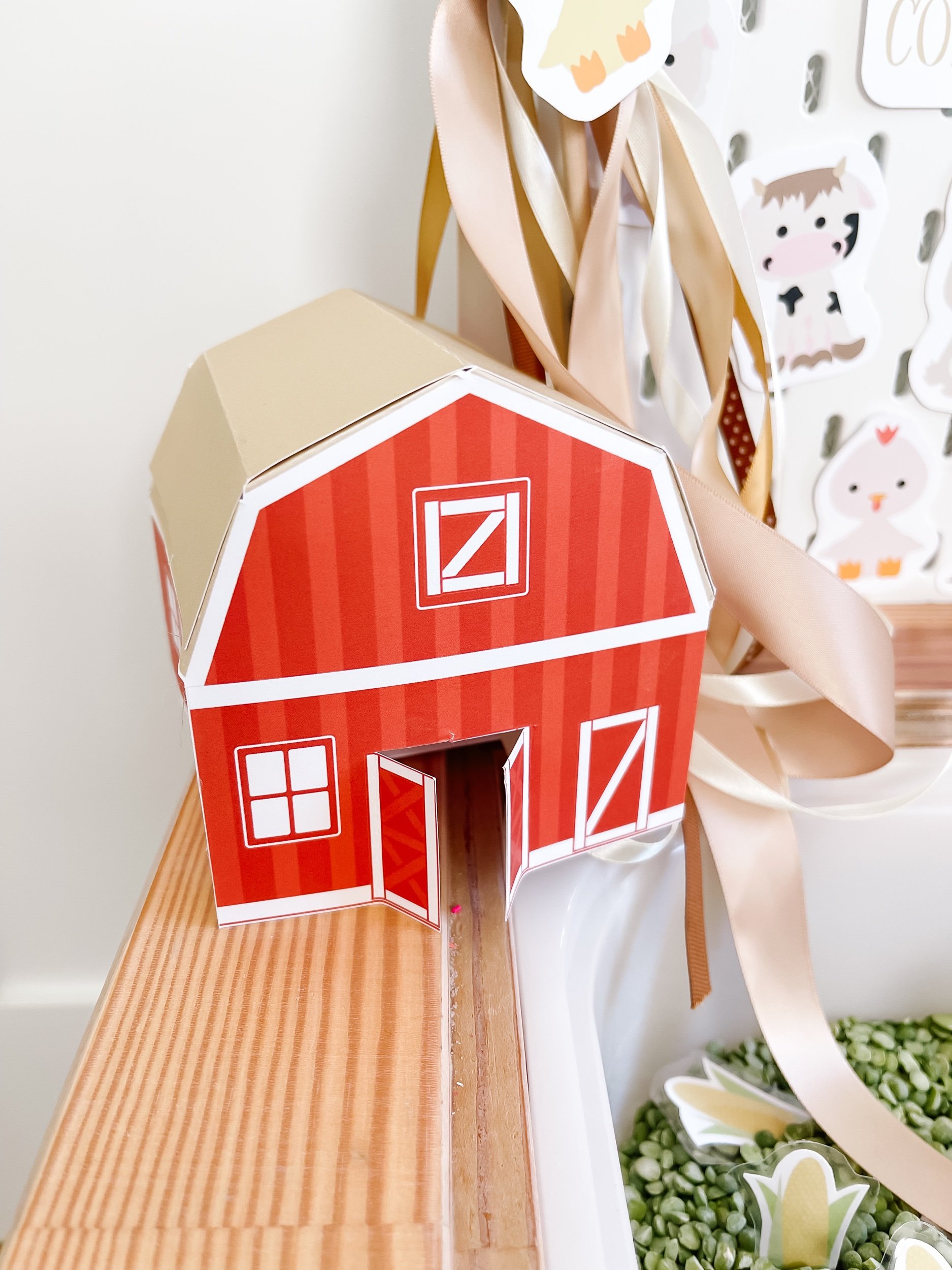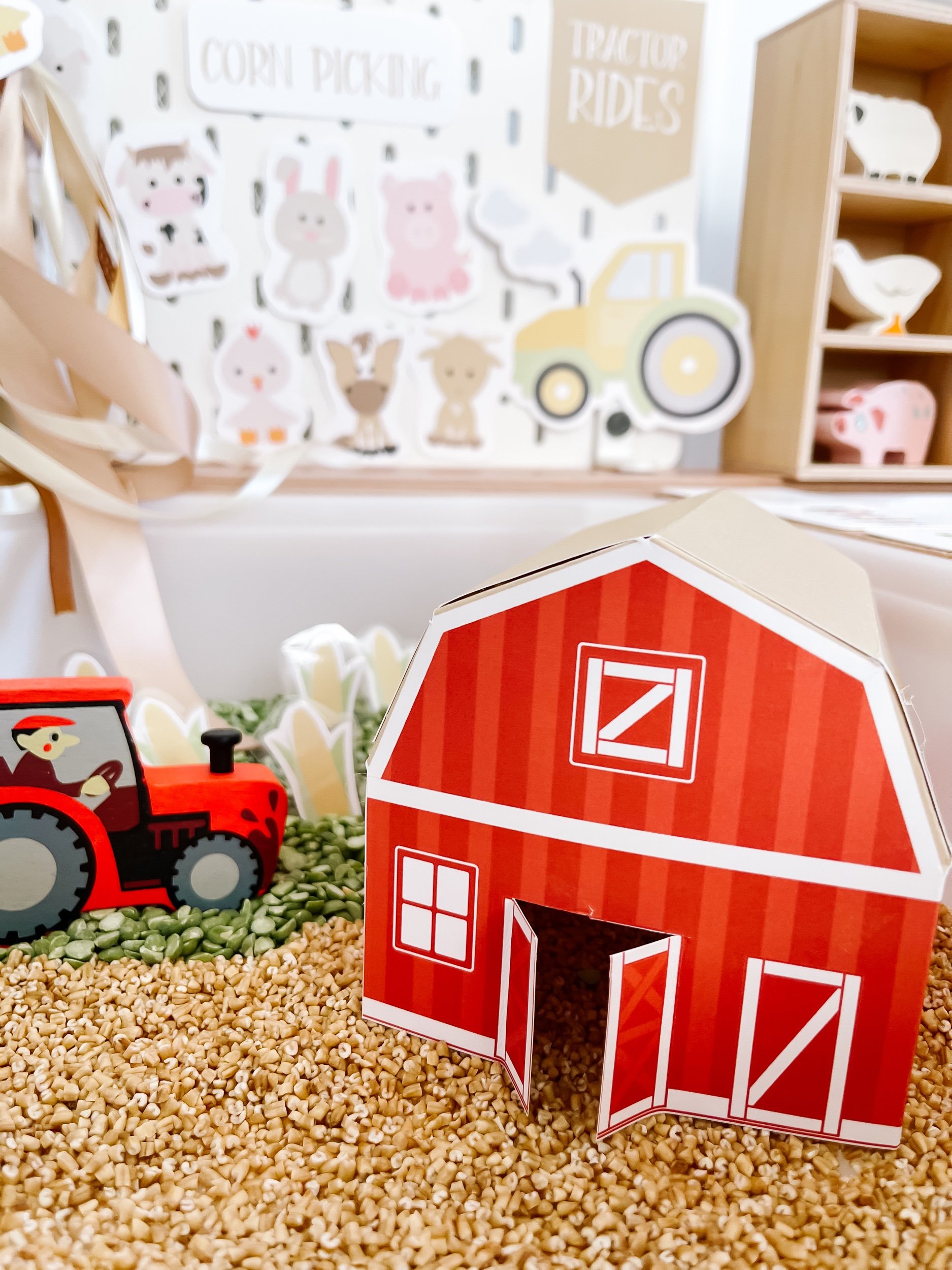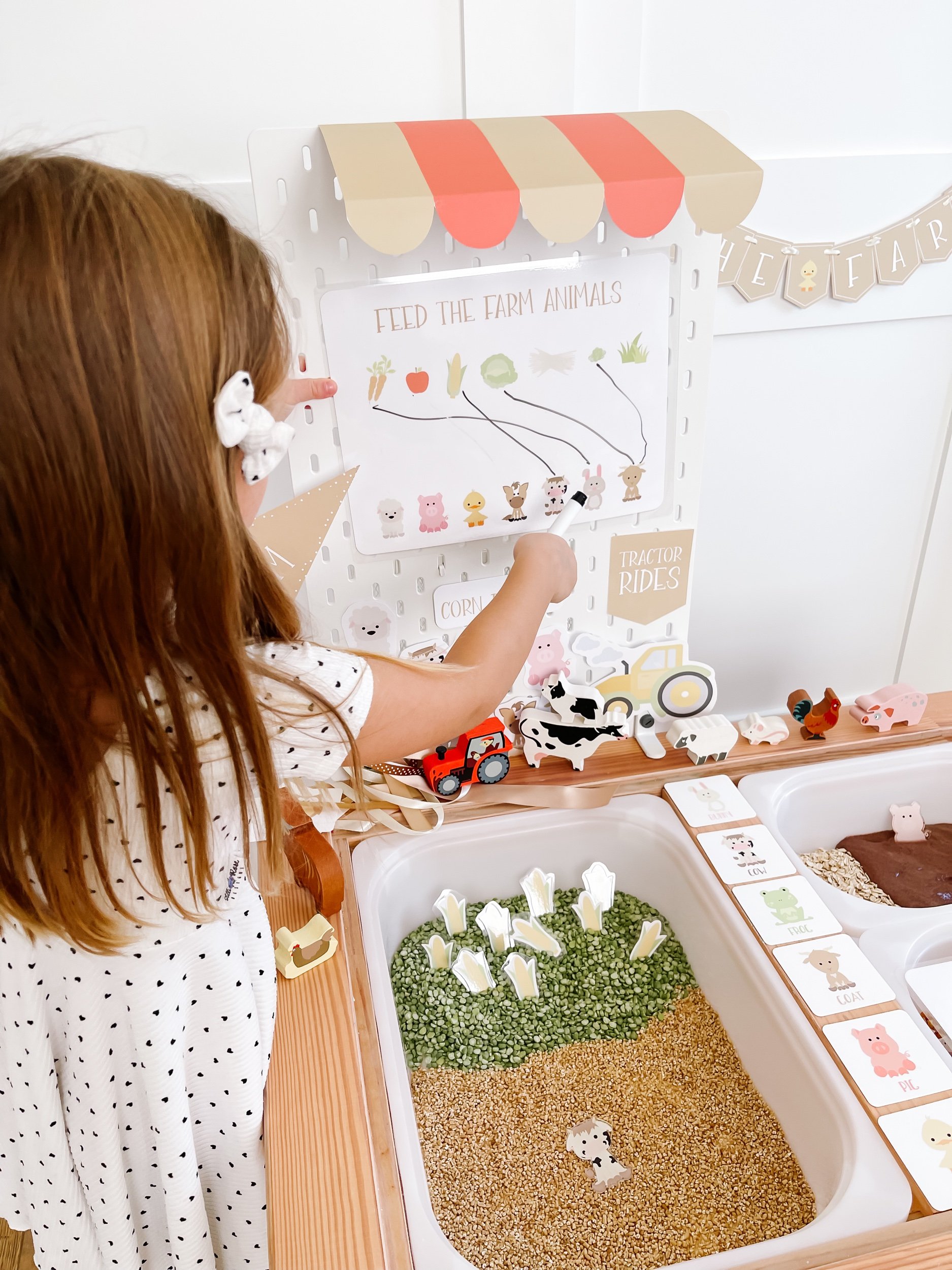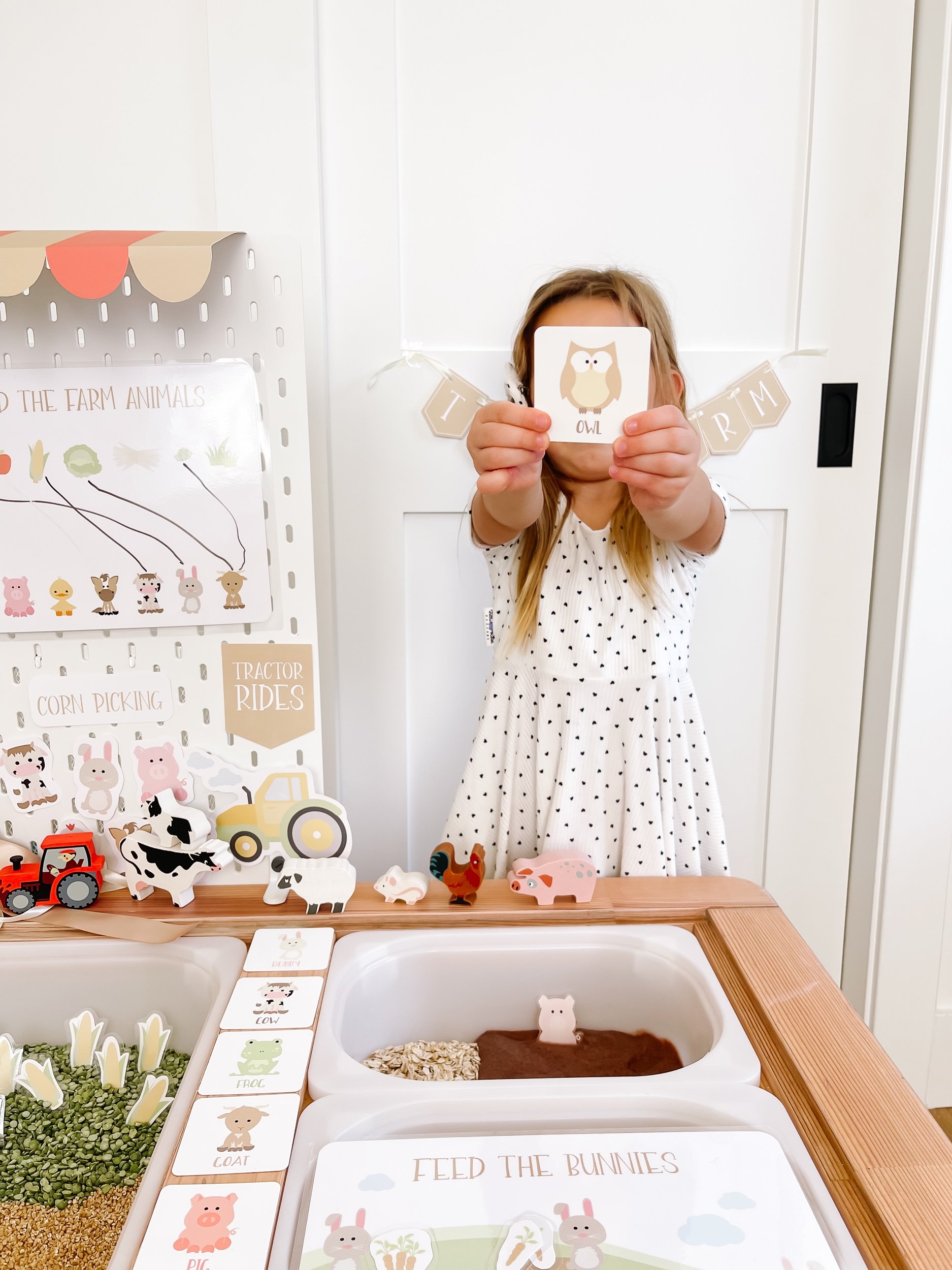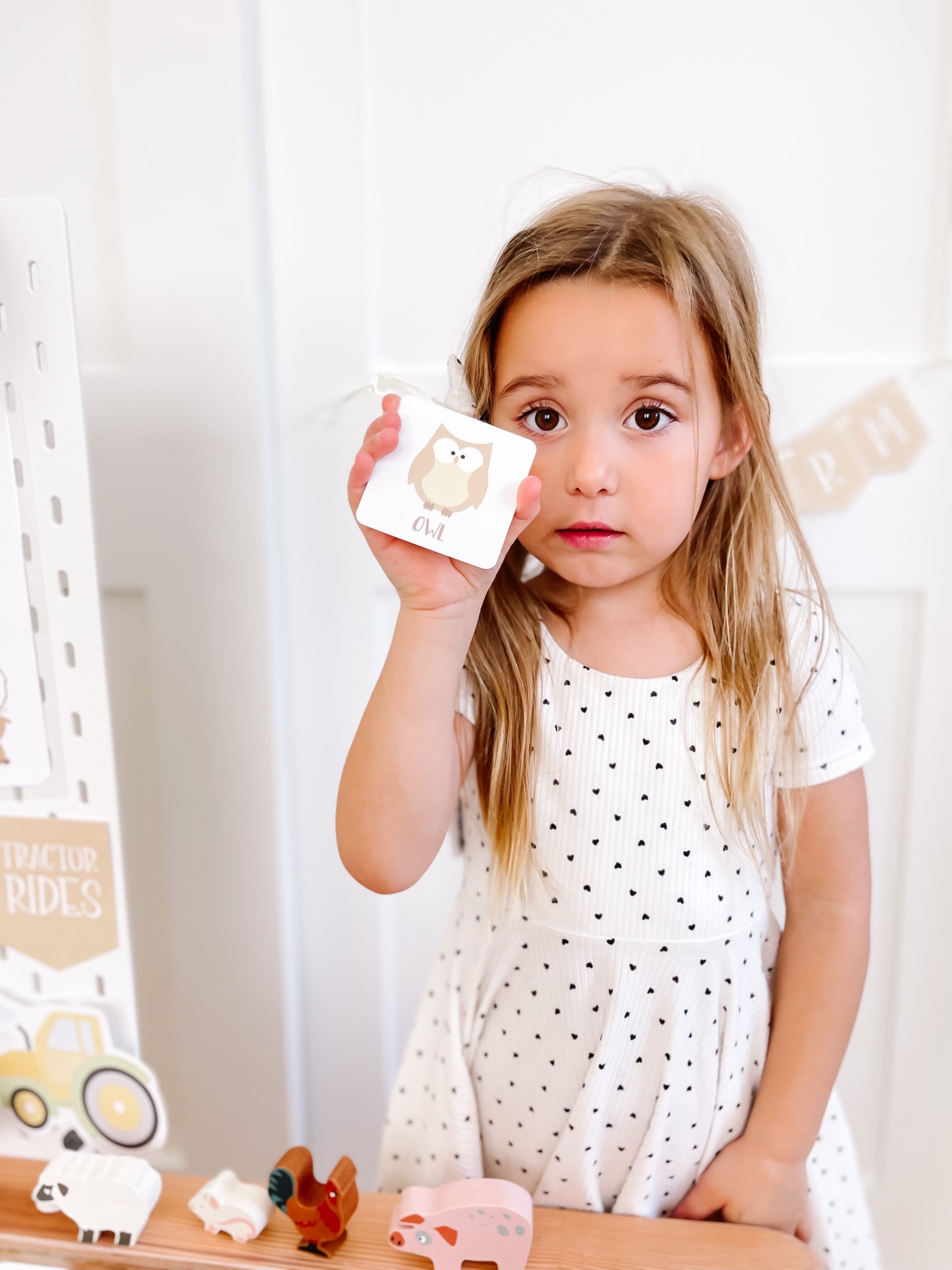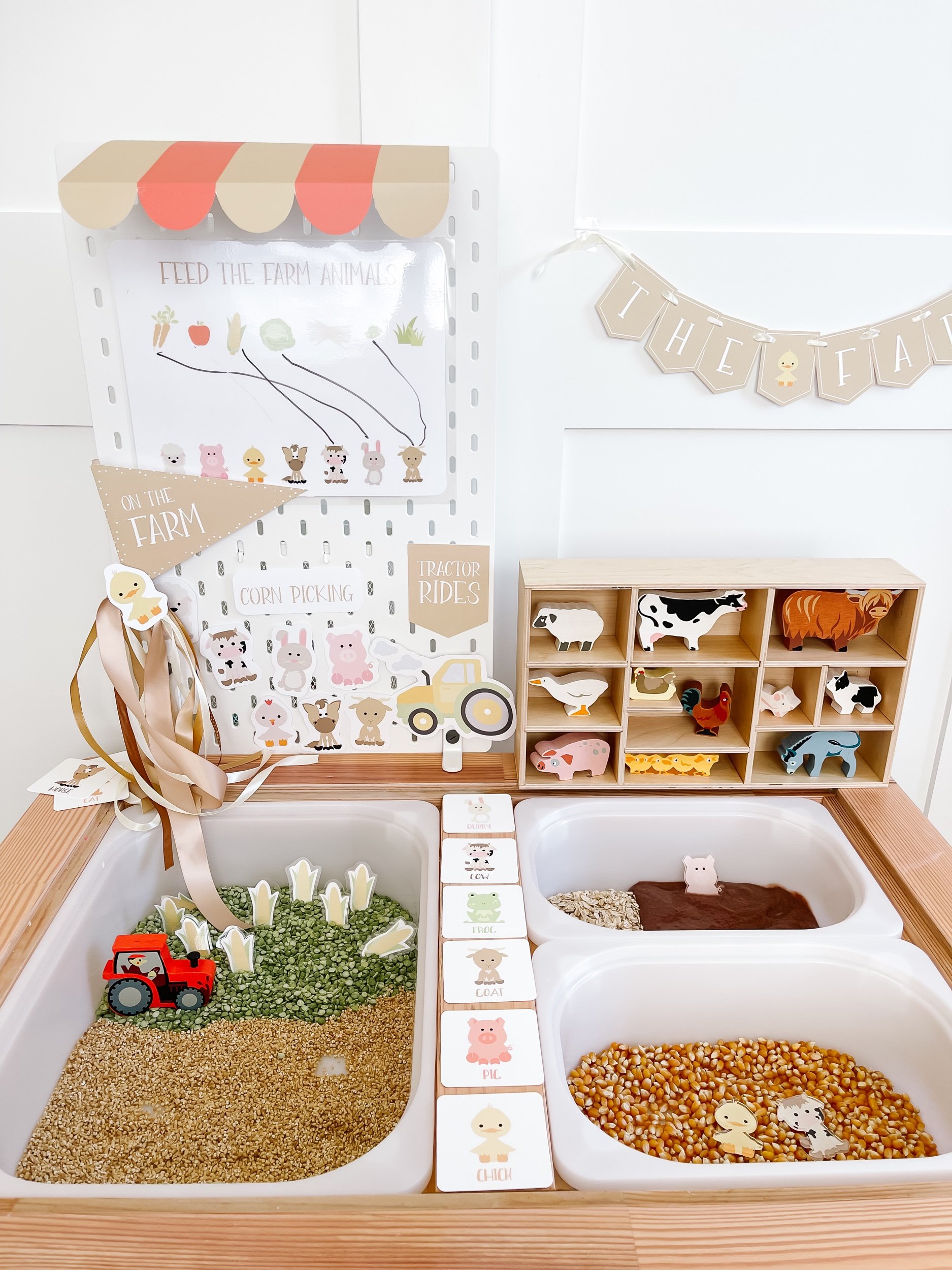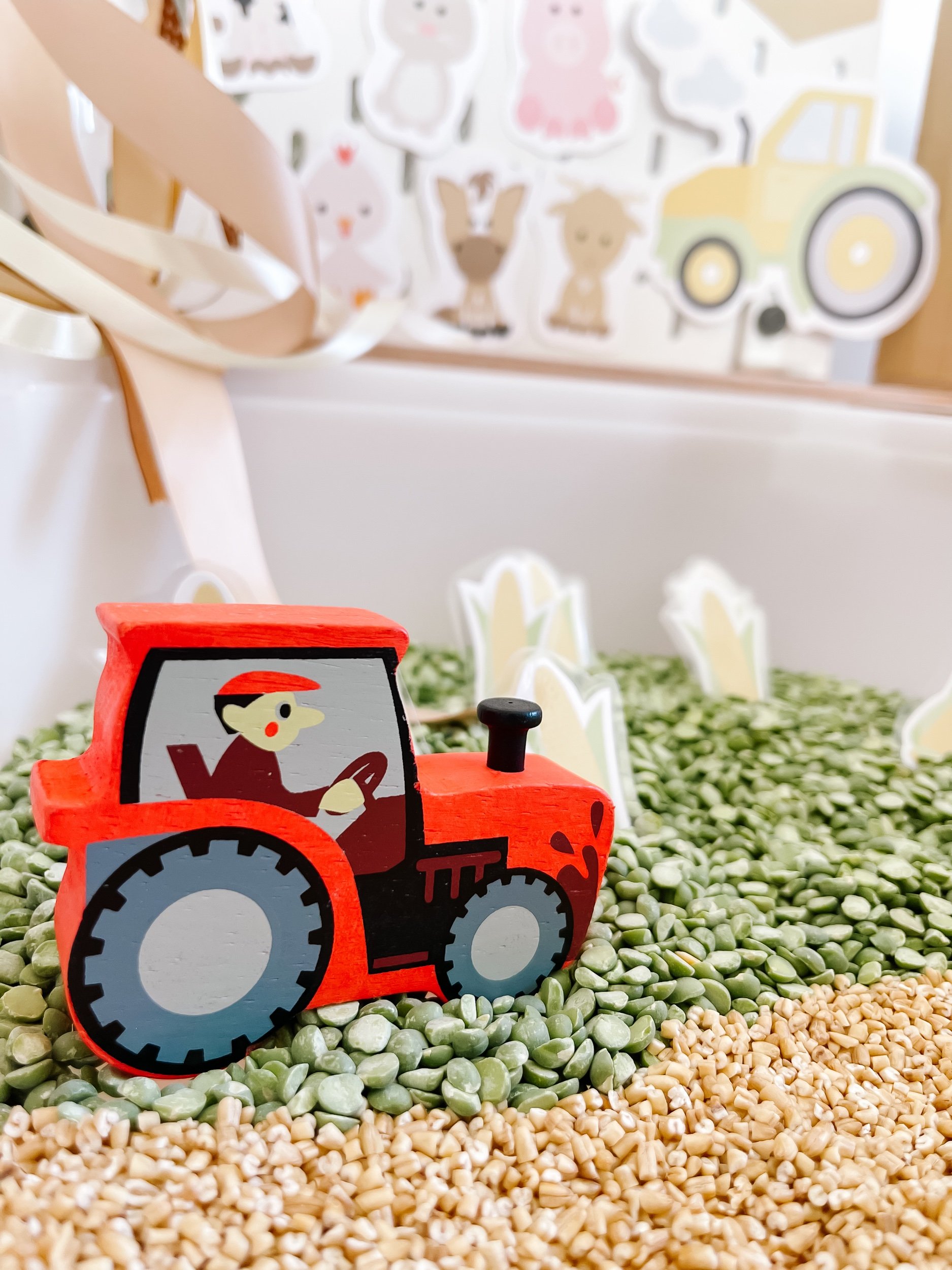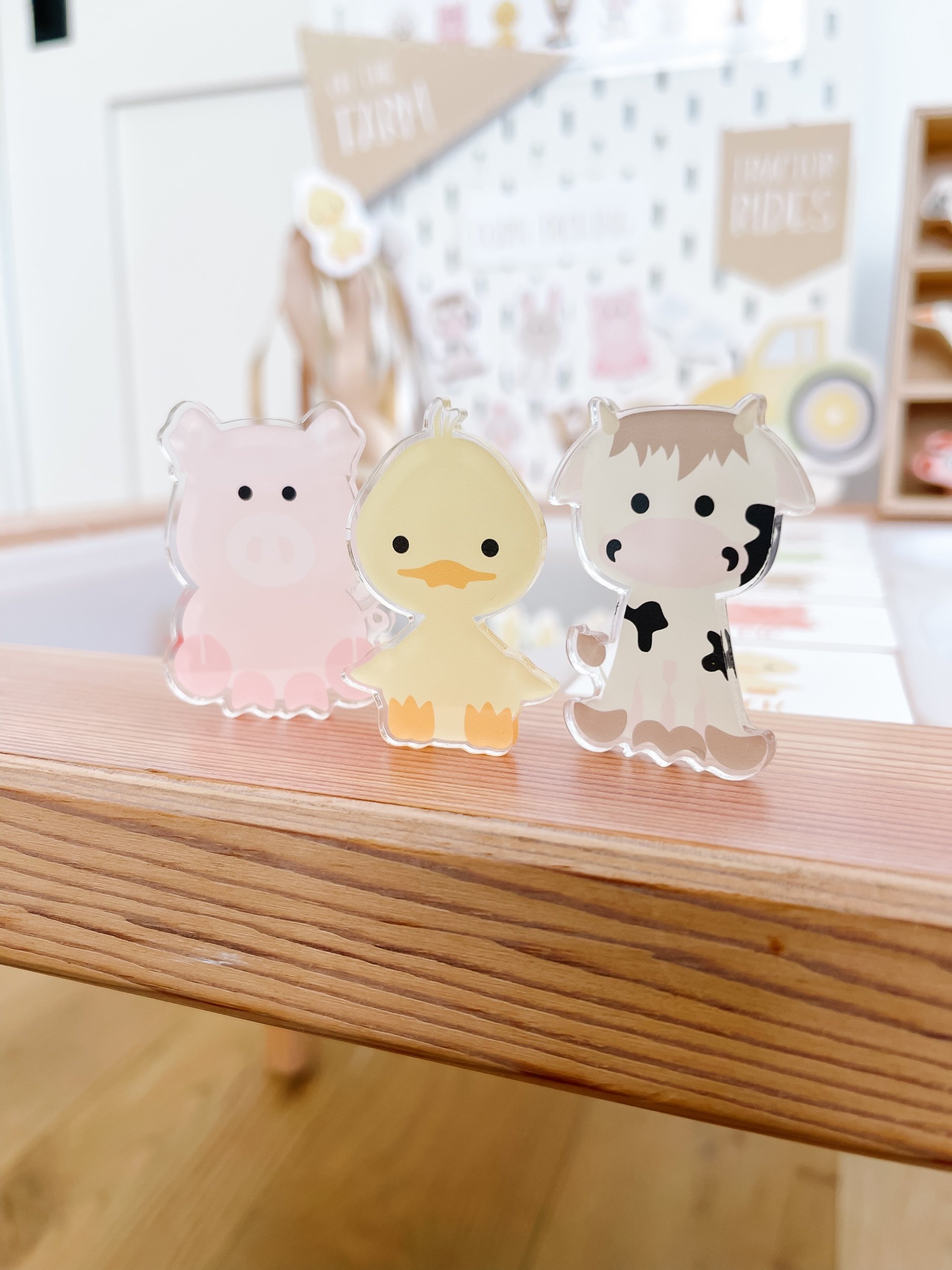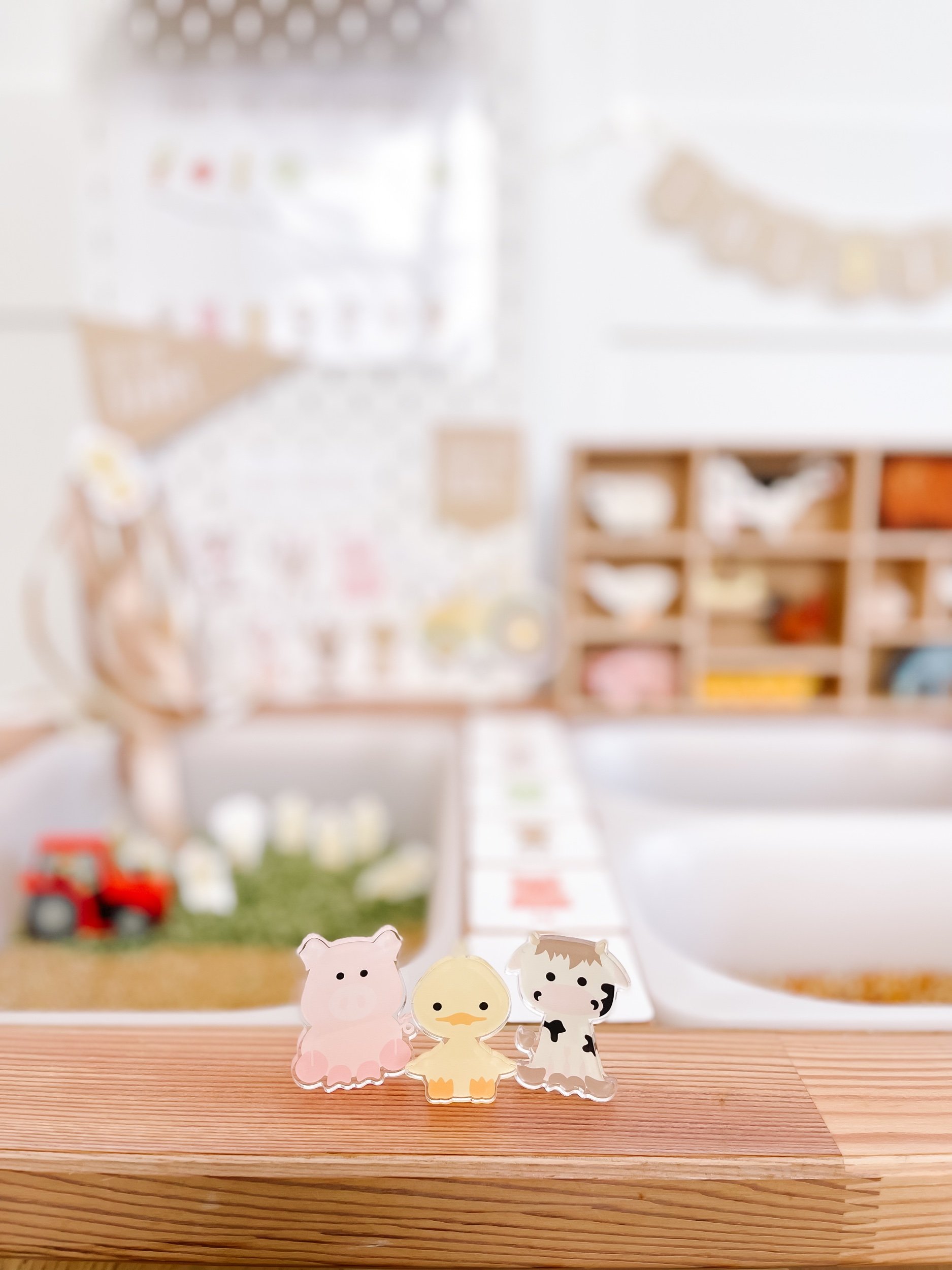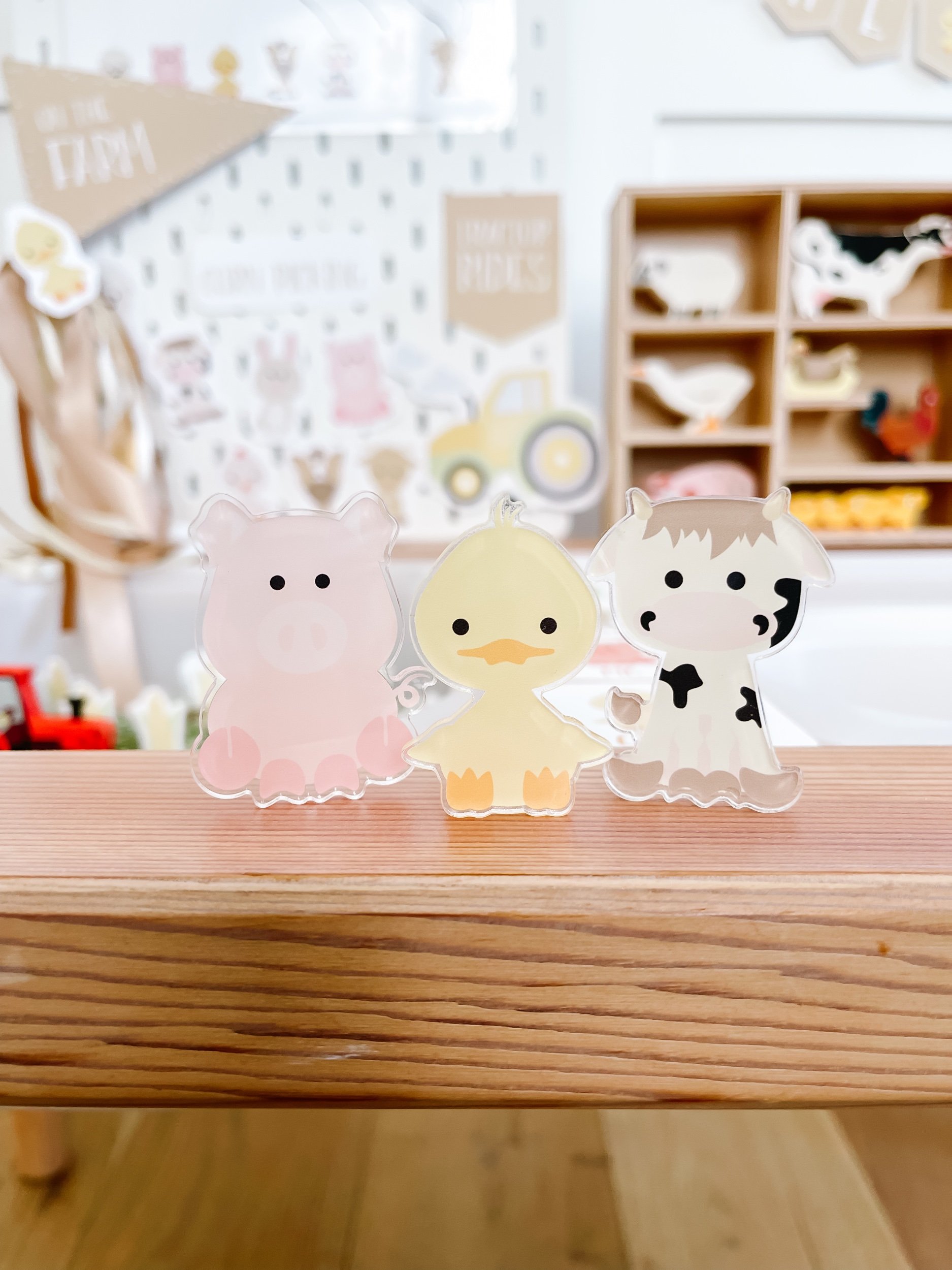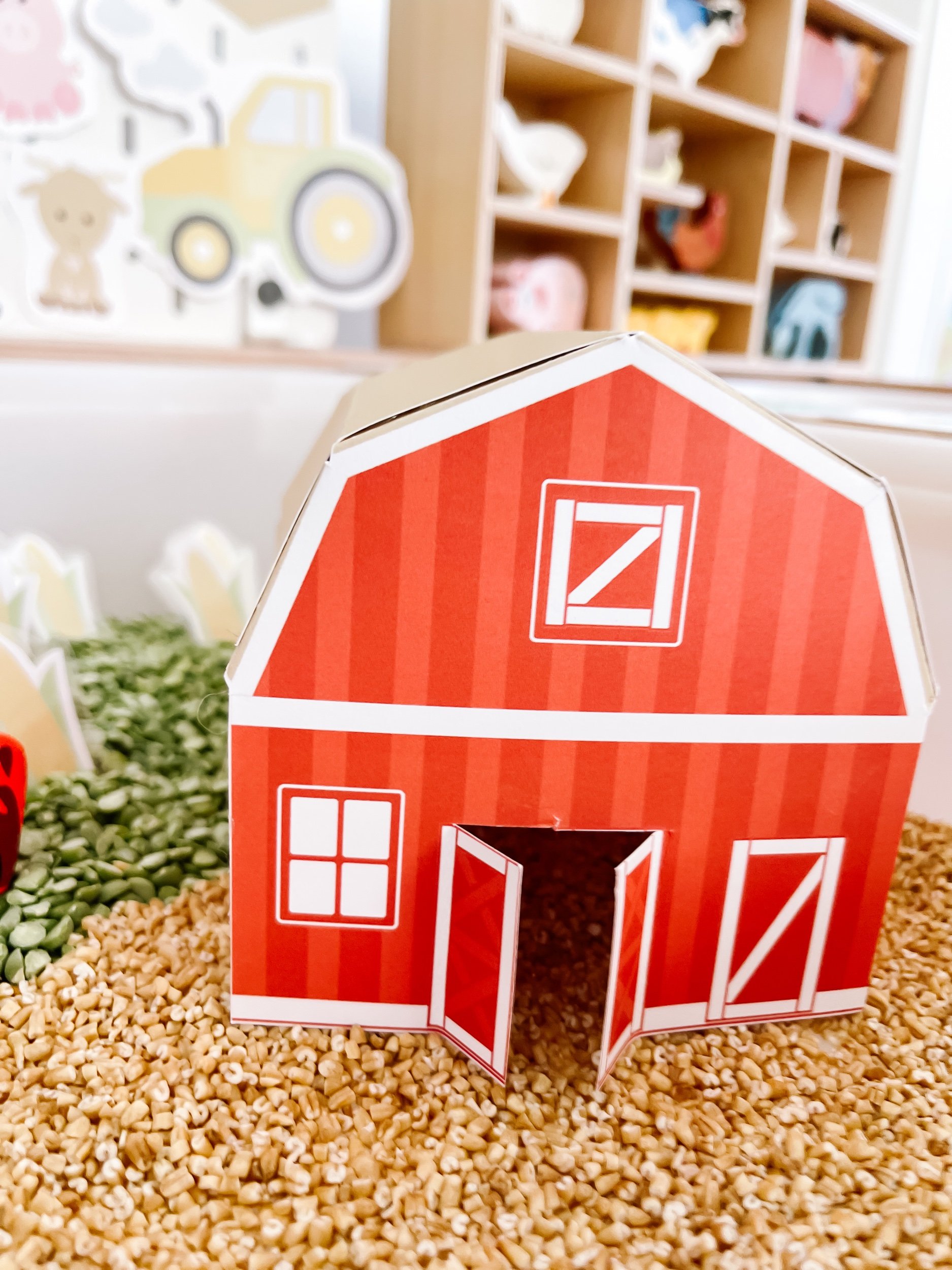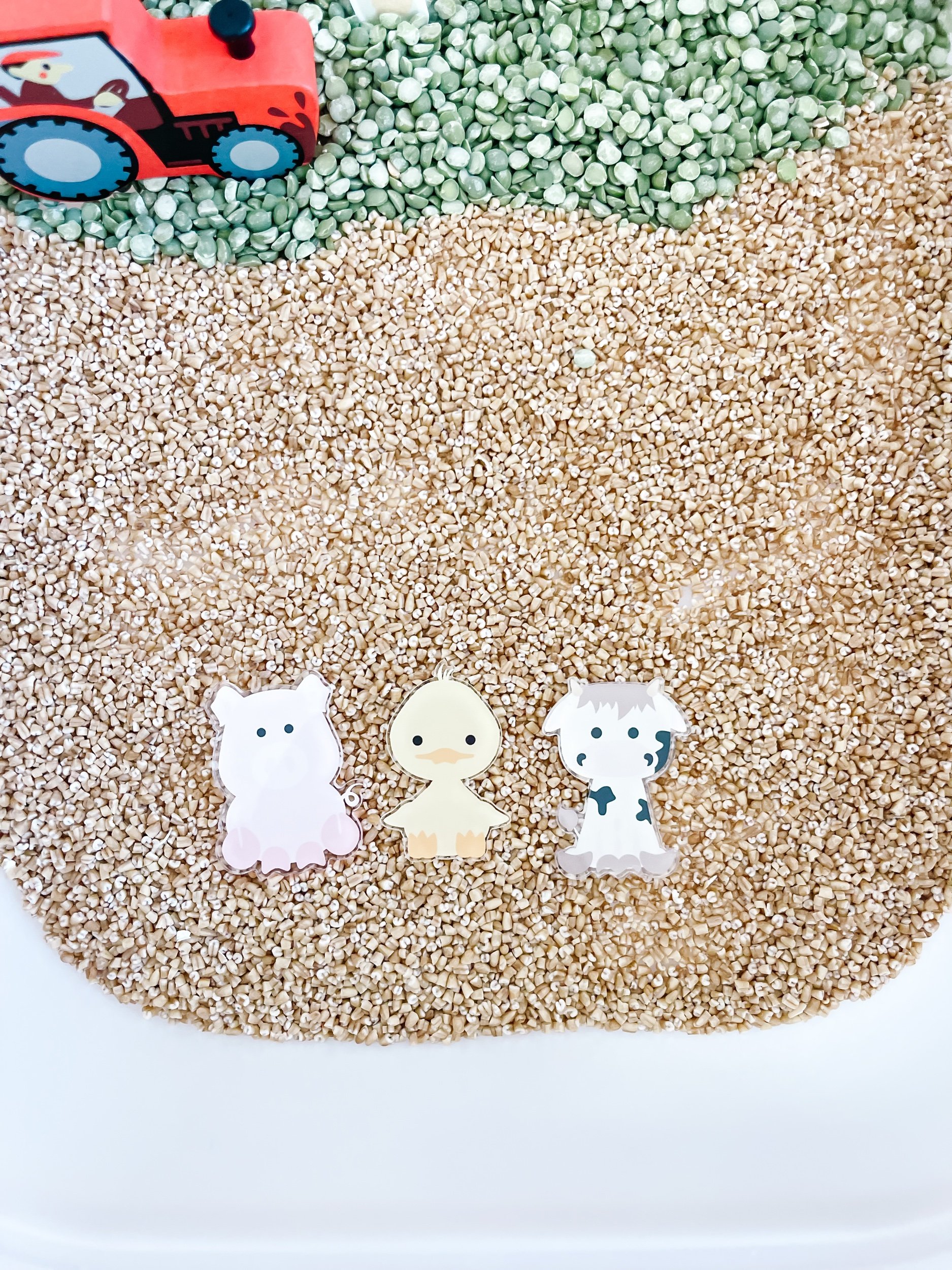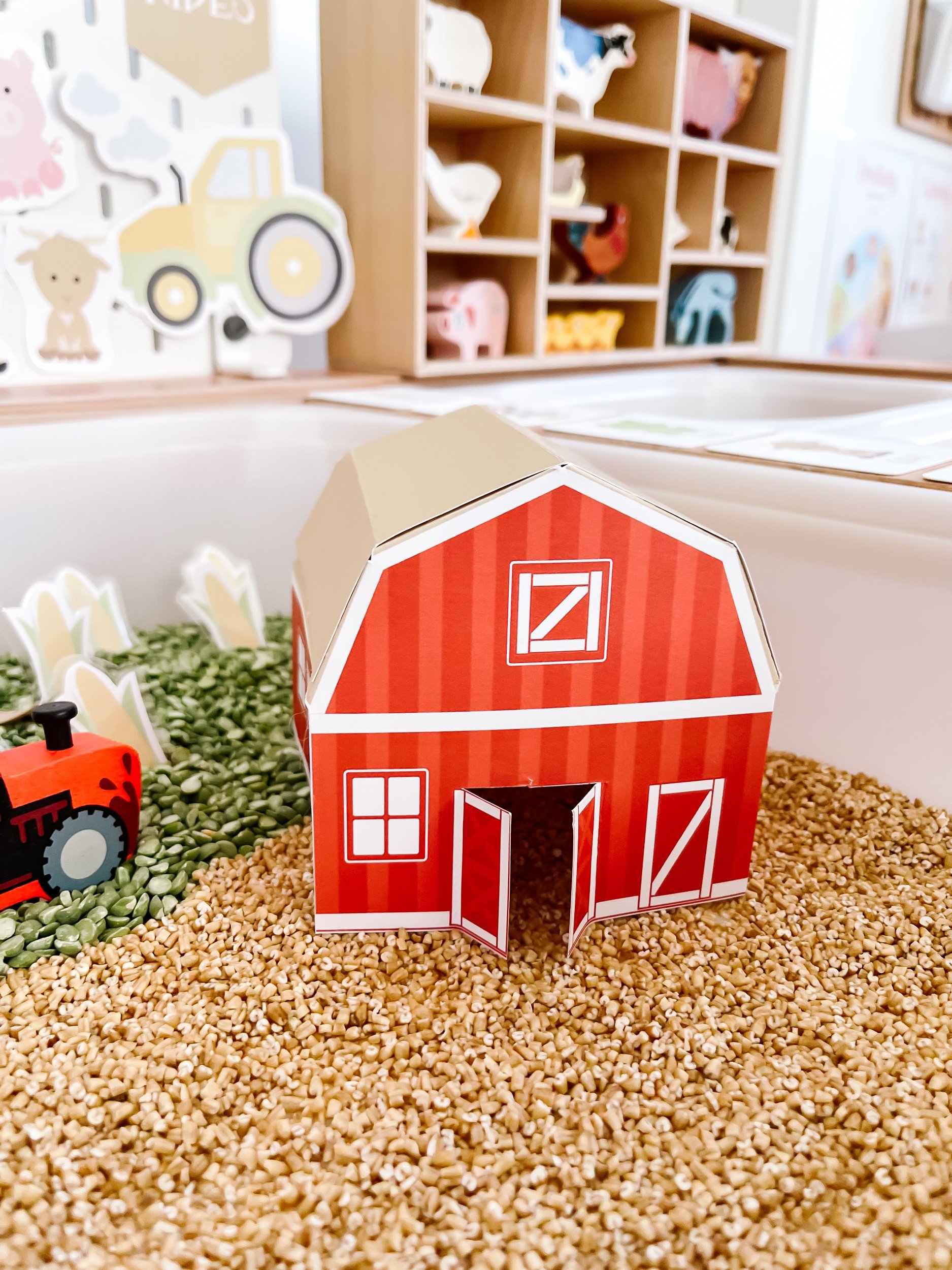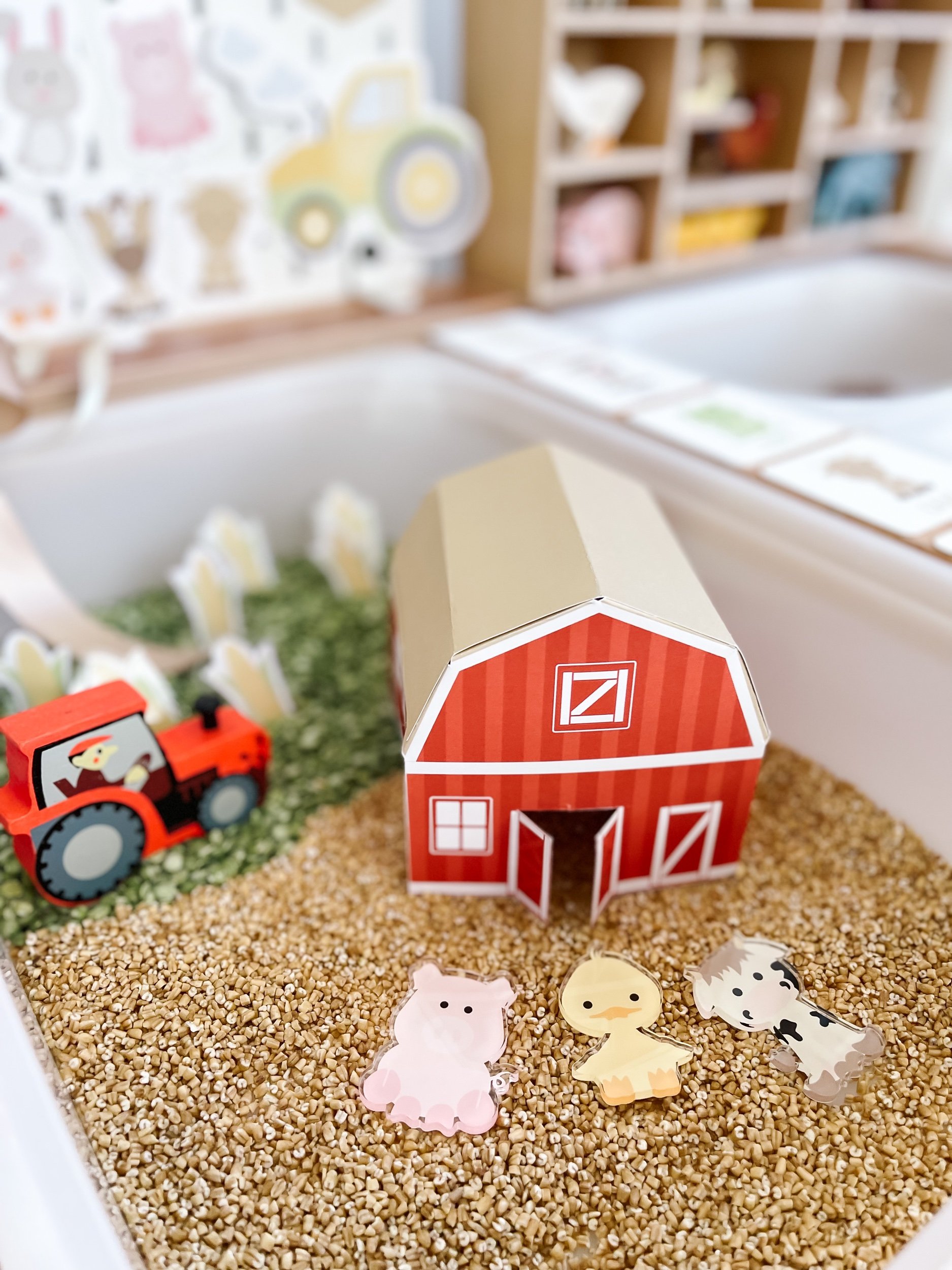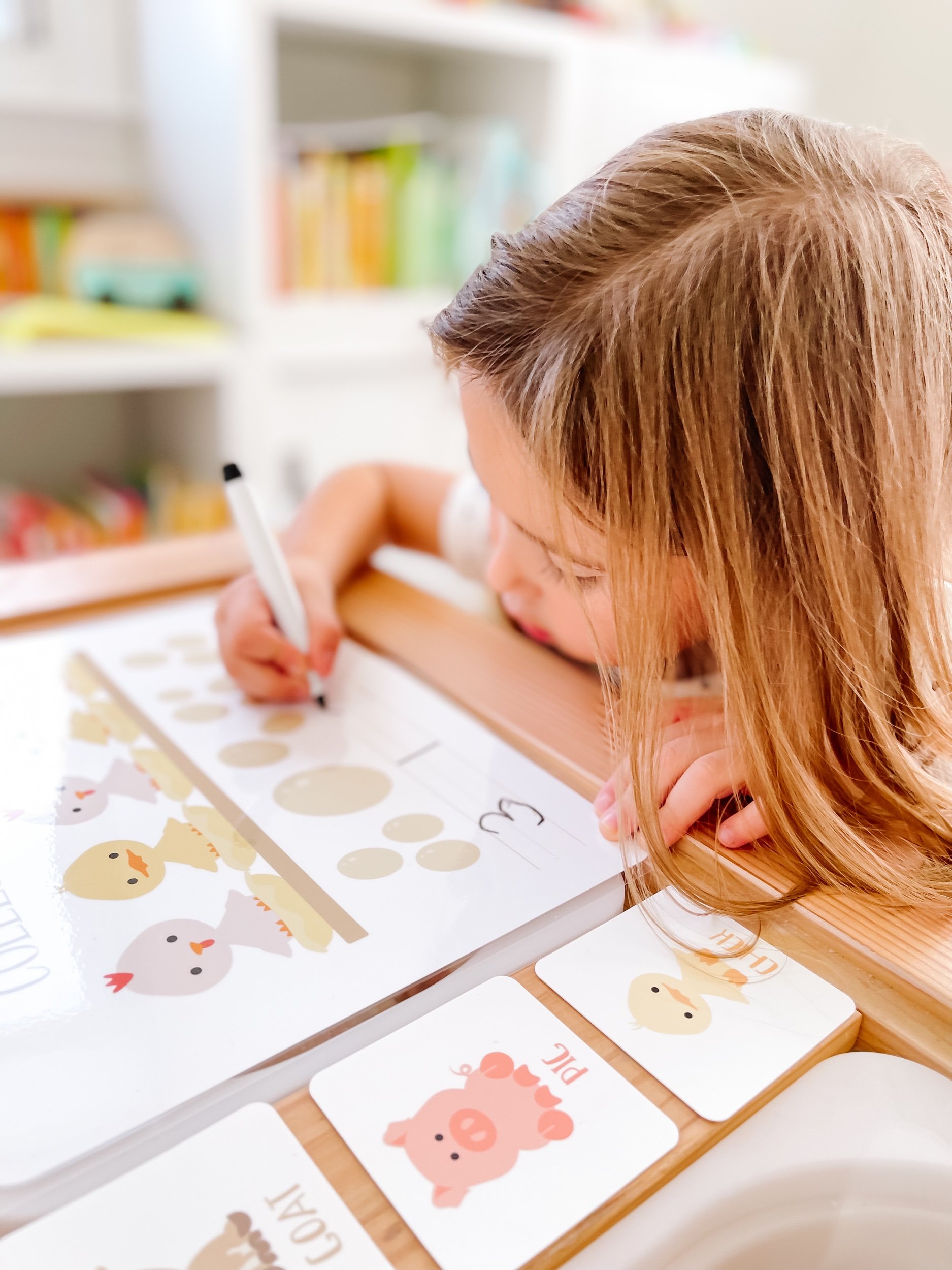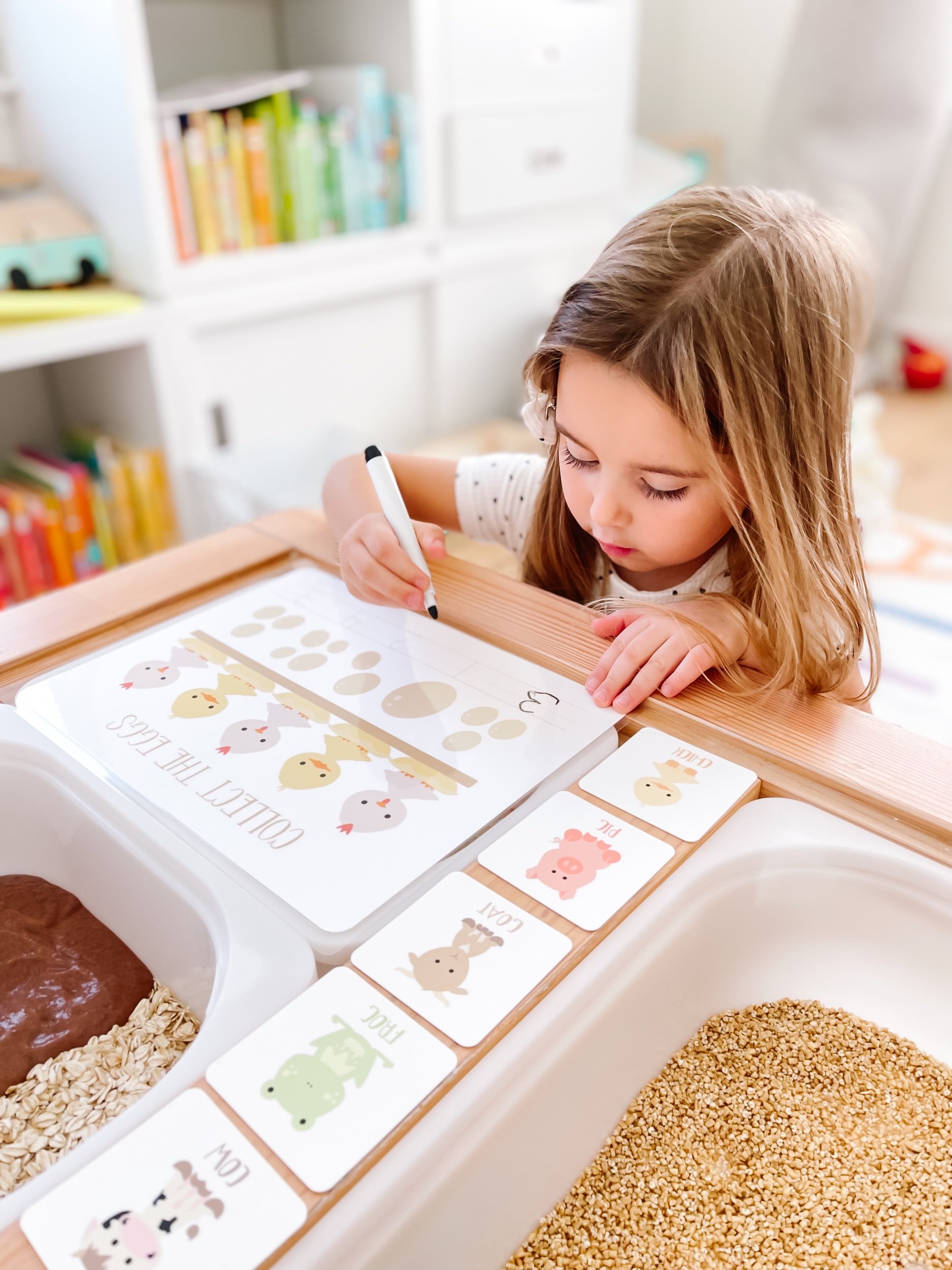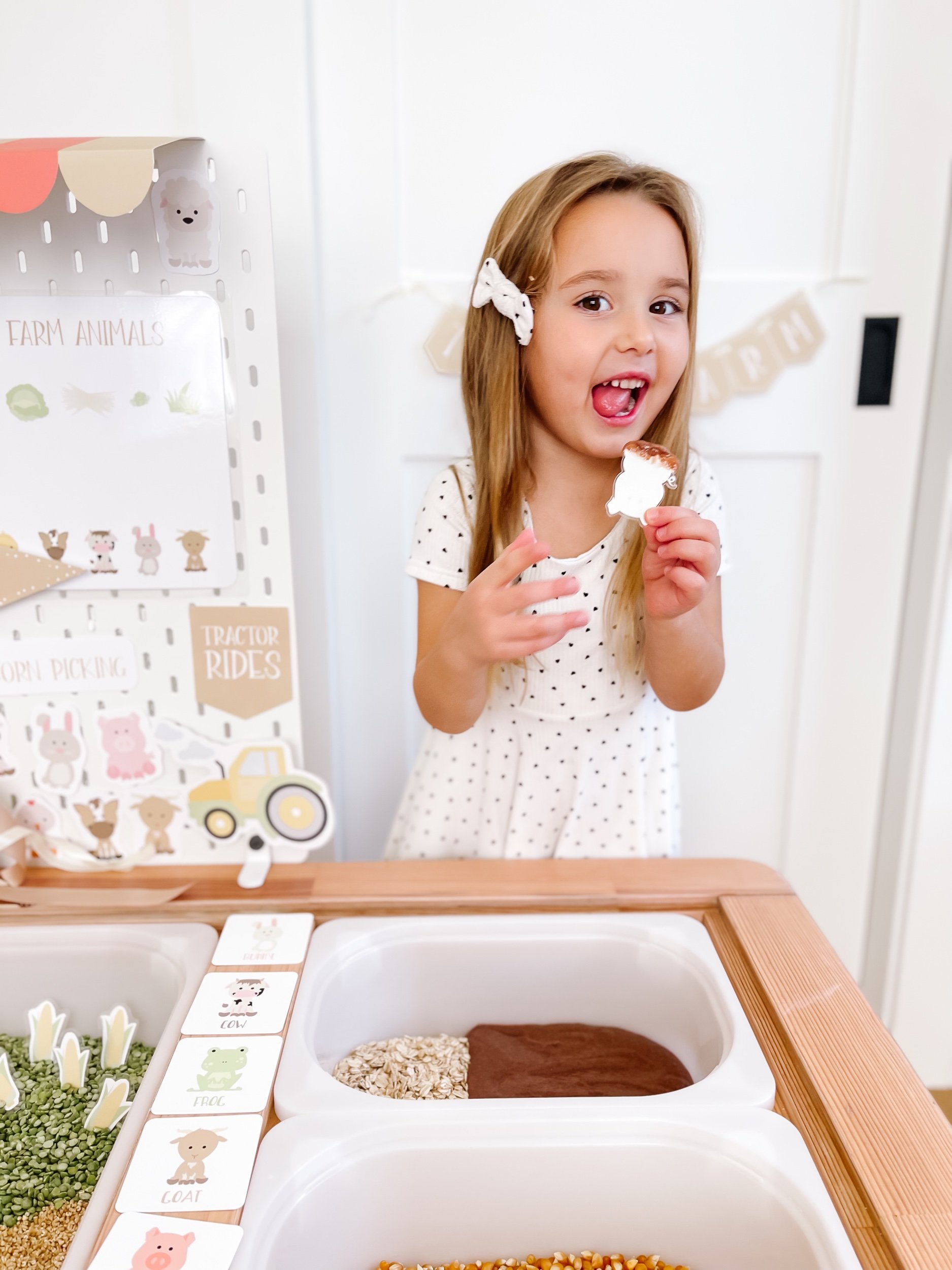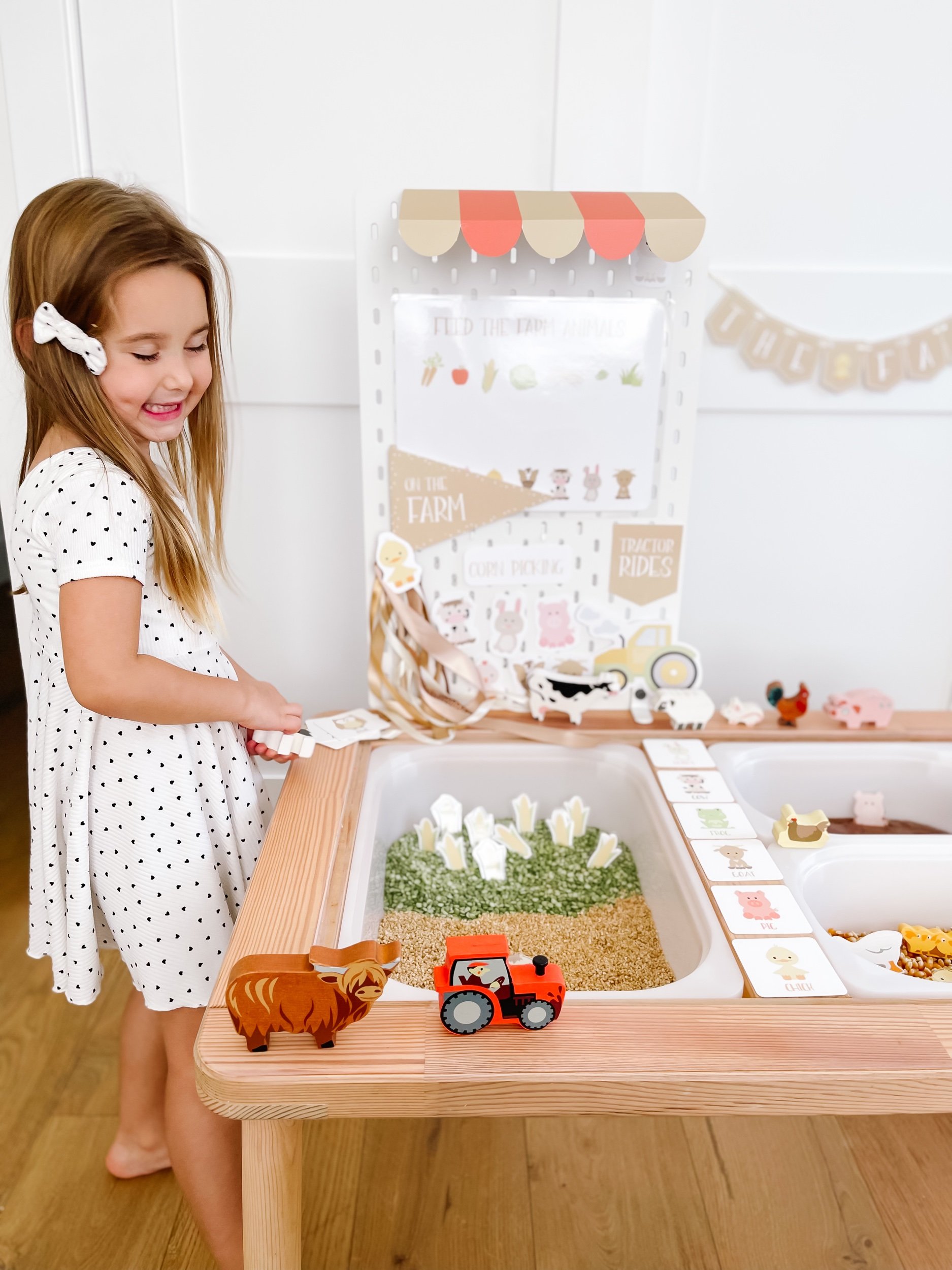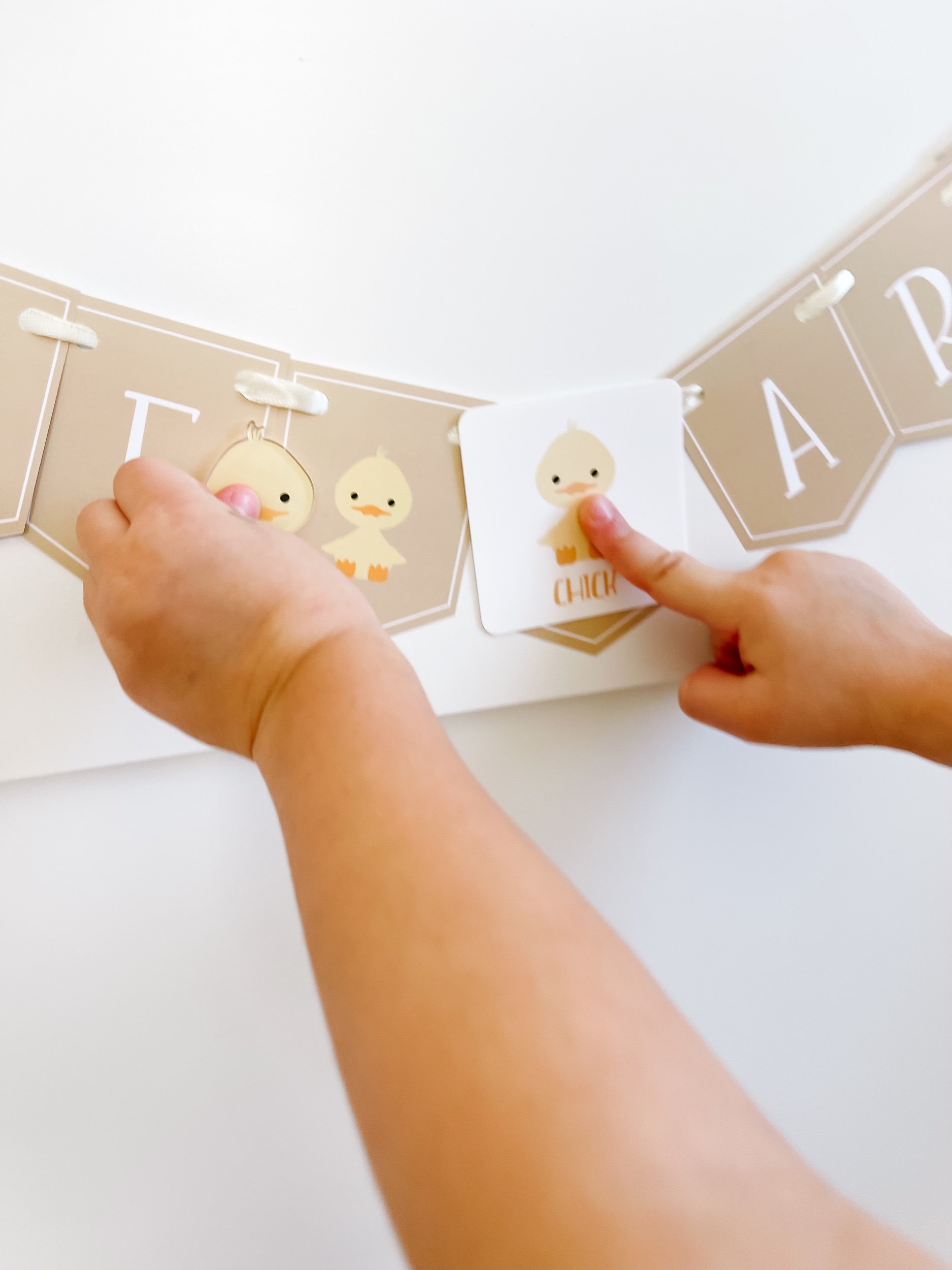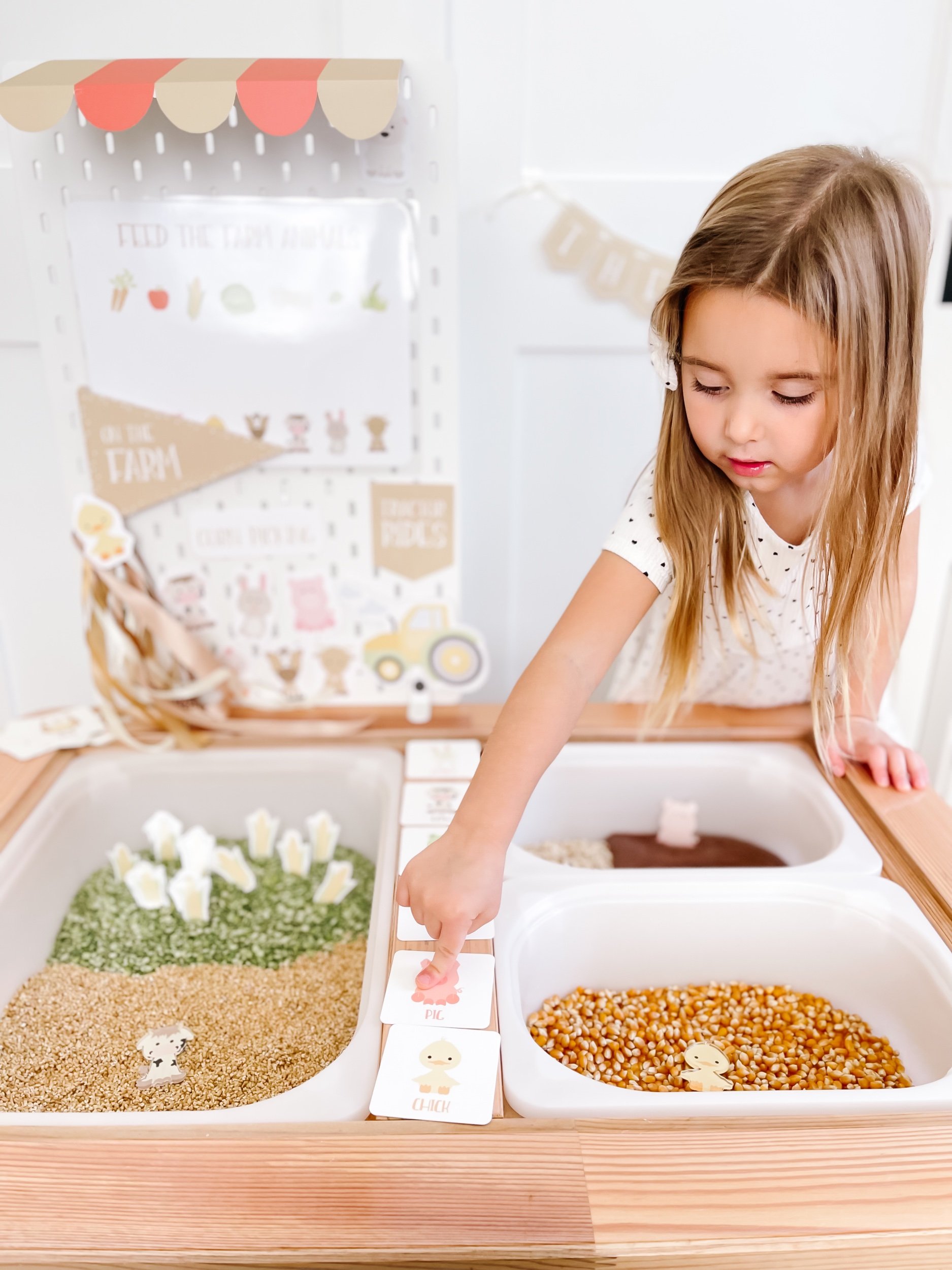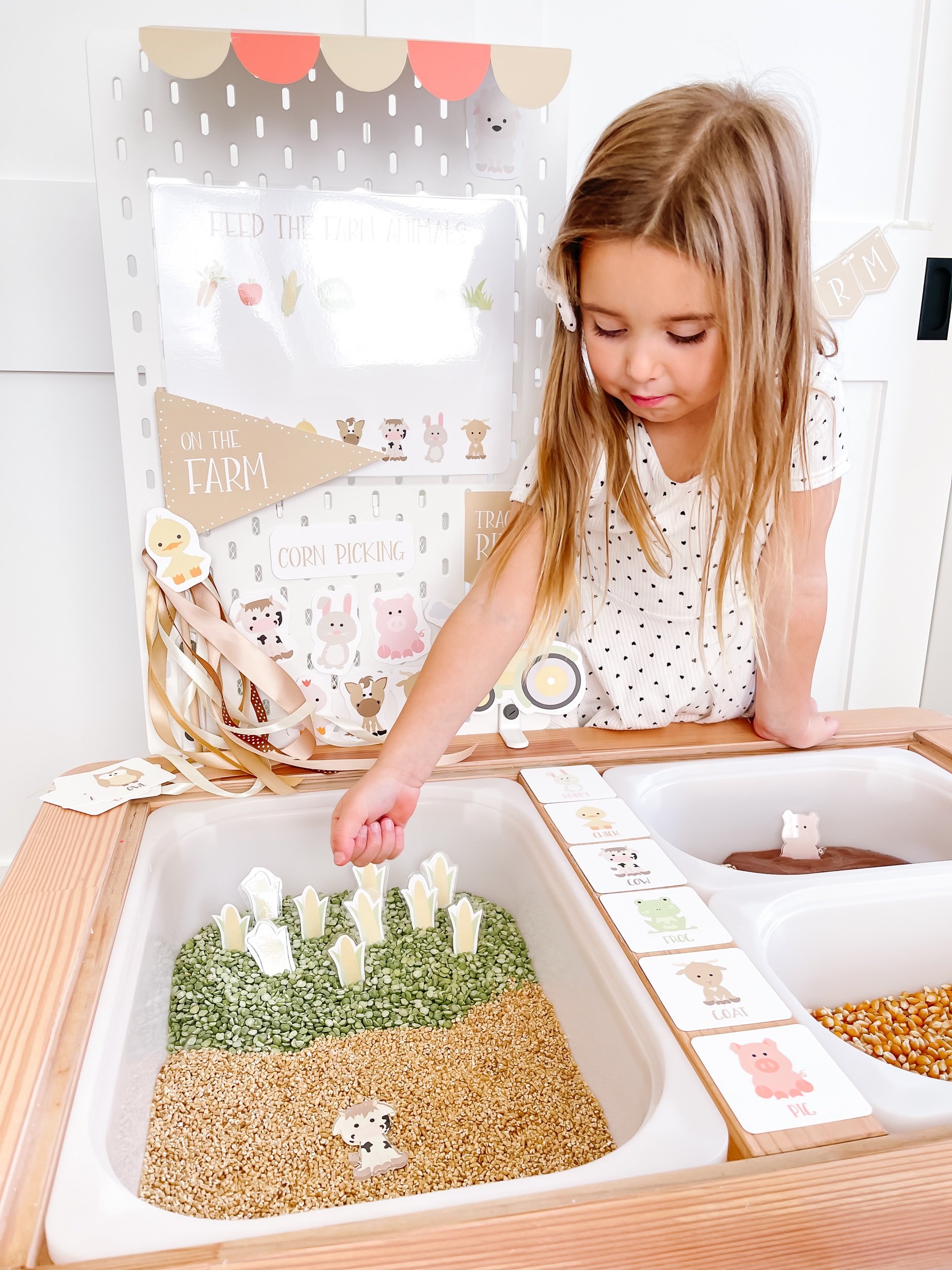Farm Animal SENSORY PLAY
I’m so excited to share our little farm with you! I created this setup so that Sofie could explore life on the farm and we could discuss the lifecycle of farm animals, harvesting food, and play in some fun sensory fillers. Sensory play is such an important way to learn and explore with hands-on play and I can’t wait for you to try out this theme.
Farm Animal Printable Decor Setup
For this printable play kit, you’ll get everything you need to turn your Flisat table into a farm. This kit includes a awning, print and cut farm animals, a tractor, a print and fold red barn, an “On the Farm” flag, an egg collection worksheet, a feed the bunnies worksheet, and a feed the farm animals worksheet.
Farm Animal Sensory Play Fillers
These great farm animal activities are a great way to learn about life on the farm. And a great way for your toddler to practice pouring, scooping, writing, matching, and digging skills. Let’s dive in!
Pig mud pit
For this activity, I used rolled oats oatmeal and chocolate pudding for the mud. After you mix and chill the chocolate pudding, simply dump it into the Trofast bin for sensory play. I paired this with my farm animal acrylic charms which are easy to dunk and dip and then wipe (or lick) clean. Pudding is a great sensory filler because it’s taste safe — it can be used for mud and dirt in all kinds of play like farm and construction.
Print and Fold Barn
For this activity, you’ll want to cut out the printable barn. Then I recommend scoring along the fold lines to make folding easier. I printed on 80lb cardstock. Once you’ve scored and folded along all of the lines, you can begin assembling from any point adding glue to the brown glue areas. Make sure you trim the top of the bar to fit before you start gluing. Cut the center line and top lives of the barn door if you want it to open and close. Once assembled, you can play with farm animal figurines. A print and fold barn is a great way to enjoy sensory play without investing in a lot of additional toys. If you use tape or velcro dots, you can easily unfold and store flat.
Corn Field
For this activity, we’ll use steel cut oatmeal and dried green peas. You can use this to make a field of grain and also a corn field using the print and cut corn. You can also use these cute little corn erasers if you want a physical corn object to burry and find in the peas. Steel cut outs turned out to be such a satisfying filler -- it’s so small and has a lovely texture. Sofie couldn’t put it down.
Feeding the farm animals
This printable activity is great for early writers who are still learning how to hold a pen. I printed and laminated this activity so that Sofie could do it over and over again. Challenge your kiddo to match each of the foods with each of the animals who eats them and use it as an opportunity to discuss what farm animals eat and how farms can be self-sustaining ecosystems.
Counting and collecting Eggs
Count the eggs that each chicken lays and write the number on the dotted line! This activity is great practice for more advanced learners who are ready to practice counting and writing. You can make this activity easier or harder by helping your little one with each part. You can also bring this activity to live by hiding some wooden eggs in a bin and having your child collect and count them.
Farm Pretend Play
Use the farm animal cut outs to play make believe farm! This is Sofie’s favorite part of play because she loves imaginative play. If you don’t have wooden farm animal figurines, you can use GoodnightFox acrylic farm animals as a great cost-effective alternative, or use GoodnightFox memory game cards. Or just use the cut out version included in the kit. You can laminate them for extra durability, plus they stay flat for easy storage. Here are some ideas for imaginative play if you need help getting started:
Have the cows grazing on corn
Pretend to shave the sheep for it’s wool
Pretend to feed the chickens corn meal
Pretend to collect the eggs from the hens
Pretend to drive the tractor through the corn field and collect the corn
Pretend to have the pigs roll around in the mud
Have the farm animals interact with each other
The Benefits of Farm Animal Themed Sensory Play for Toddlers
Sensory play is an excellent way for toddlers to explore and learn about the world around them. It engages their senses, stimulates their brains, and promotes their overall development. One fantastic sensory play theme for toddlers is farm animal themed play. Introducing little ones to the wonders of farm animals through sensory play can offer a wide range of benefits that go beyond mere entertainment. Let's delve into some of these benefits.
1. Cognitive Development: Farm animal sensory play provides toddlers with opportunities to improve their cognitive skills. As they engage in hands-on activities involving farm animal toys, they learn to categorize, sort, and match animals based on their characteristics. This fosters early problem-solving skills, critical thinking, and the understanding of cause and effect relationships.
2. Language and Communication: Sensory play with farm animals also promotes language and communication skills in toddlers. As they play with different animals, parents and caregivers have countless opportunities to engage in conversations, teach new words, and help them develop their vocabulary. Describing the features, sounds, and actions of farm animals enhances their language acquisition and expressive abilities.
3. Sensory Exploration: Farm animal themed sensory play stimulates various sensory experiences for toddlers. The textures of straw, hay, feathers, and faux fur tickle their tactile sense and help develop fine motor skills as they manipulate objects. The sounds of animal noises and the rhythm of songs encourage auditory development. Visual exploration of colors, shapes, and patterns on the animals' bodies enhances visual perception.
4. Emotional Development: Interacting with farm animals during sensory play helps toddlers develop empathy and emotional intelligence. Through caring for and imitating the behaviors of the animals, toddlers learn to recognize and respond to the emotions of others. This fosters kindness, compassion, and an understanding of nurturing relationships.
5. Role-Playing and Pretend Play: Farm animal themed sensory play encourages imaginative and pretend play, which is crucial for a toddler's development. They can engage in role-playing by pretending to be farmers, veterinarians, or animal caretakers. This imaginative play allows them to understand different perspectives, practice social skills, and experiment with problem-solving in a safe and enjoyable way.
6. Connection to Nature: Sensory play with farm animals connects toddlers with nature, even if they don't live near a farm. It helps them develop an appreciation for the natural world and its creatures. Through farm animal-themed play, toddlers learn about the environment, seasons, and the importance of caring for living beings.
In conclusion, farm animal themed sensory play offers toddlers a multi-faceted learning experience that benefits their overall development. As they engage in cognitive tasks, language building, sensory exploration, emotional growth, imaginative play, and nature connection, little ones experience a holistic learning and developmental journey. So, next time you're planning sensory play activities for your toddler, consider the wonders of farm animal-themed play and watch their excitement and growth unfold.
Farm Animal Vocabulary Words for Toddlers
1. Cow: A large domesticated mammal with a characteristic moo sound, often raised for milk and meat.
2. Horse: A four-legged animal that is used for riding, racing, or working on farms, known for its powerful galloping.
3. Pig: A stout mammal with a snout that enjoys rolling in the mud and is often farmed for its meat.
4. Sheep: A fluffy, woolly animal that is raised for its soft wool and often heard baa-ing.
5. Chicken: A small domesticated bird that lays eggs and is often raised for its meat.
6. Duck: A waterbird with flat webbed feet, a quacking sound, and the ability to swim gracefully.
7. Goat: A sure-footed mammal often found on farms, known for eating grass and sometimes kept for milking.
8. Dog: A loyal and friendly domesticated mammal that loves to bark and is often kept for companionship.
9. Cat: A small carnivorous mammal prized for being independent, purring, and engaging in playful antics.
10. Donkey: A sturdy domesticated mammal that resembles a horse but is smaller and usually used for work.
11. Rooster: A male chicken known for its cock-a-doodle-doo crowing in the early morning.
12. Hen: A female chicken that lays eggs and is often seen clucking around the farm.
13. Turkey: A large bird often consumed on special occasions, known for its gobbling sound.
14. Rabbit: A small animal that hops on its hind legs, with long ears and a fluffy tail.
15. Goose: A large waterbird, often raised for its meat, that hisses and honks.
16. Bee: A flying insect known for its buzzing sound, ability to produce honey, and pollination.
17. Piglet: A young pig who is smaller in size and usually found on a farm.
18. Lamb: The young offspring of a sheep known for its soft wool and cute appearance.
19. Chicks: The baby versions of chickens, covered with fluffy yellow feathers.
20. Calf: A young cow that is not yet fully grown, often seen on dairy farms.
21. Duckling: The cute and fluffy baby version of a duck.
22. Kitten: The young offspring of a cat, usually small and playful.
23. Pup: A term for the young of several different animals, but often used to refer to a young dog.
24. Gosling: The young offspring of a goose, often gray and fuzzy.
25. Foal: A baby horse that has not yet reached adulthood, usually found on horse farms.
These vocabulary words will help toddlers familiarize themselves with the farm animal world while engaging in sensory play.
